

Juniors I

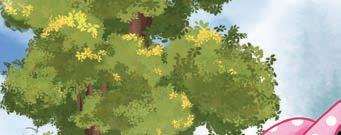
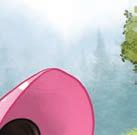

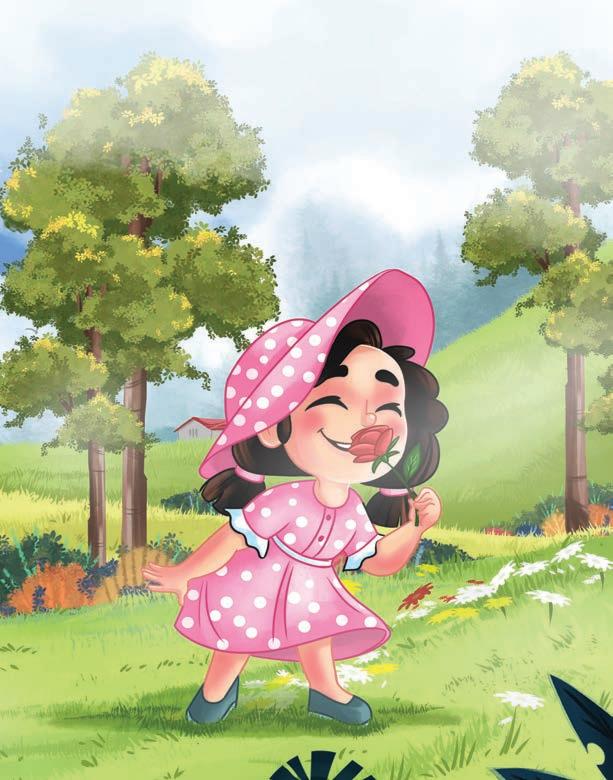

Foreword
Thanks to globalization and the emergence of technology, international boundaries have become blurred. English, to a high degree, is a commonly understood medium of communication throughout the world. It is also one of the key tools that students require to perform well. According to a global study, 98.5% of employers implicitly or explicitly assess a candidate’s English communication skills while recruiting them. There is, therefore, a growing demand for English communication skills, because it empowers people and enables them to lead a better life.
Early exposure to English is essential for children’s overall academic and personal growth. It not only facilitates effective communication but also lays the foundation for all future language learning. However, it is equally imperative to adhere to a scientific approach when introducing children to English or any second language during their foundational stages.
Highlighted by a wide range of research and also by the NEP 2020, a strong foundation in listening and speaking from an early age leads to better reading–writing skills as well as improved academic performance in the target language. In fact, special emphasis is placed on conversational and communication skills at the ECCE stage, in the NEP document. Along the same lines, the first 8 years in a child’s life are deemed critical, in the new NCF, for acquiring a language orally and which forms the basis of literacy and cognitive development.
Yet, English listening and speaking often tends to take a back seat during the early years in schools against the standard teaching practices around decoding, tracing and phonemic awareness activities. In order to address this humungous learning gap during the foundational years, Uolo has launched a powerful program for oral language development in English—Speak! It comprises two components—the Conversations book through which classroom interactions and teaching take place, and the Uolo App that houses all digital assets of the program.
Aligned with the spirit of NEP 2020 and NCF for foundational stages, Speak adheres to the communicative language approach, and gives precedence to developing listening and speaking skills in English in an anxiety-free, meaningful and fun-filled environment.
The program steers clear of teaching reading–writing and focuses exclusively on oral language development of children. The book follows a theme-based learning approach, where carefully curated themes become separate chapters and go on for a month. For example, food, seasons, good habits and body are few of the themes that are at once crucial yet easy for learners to begin their listening and speaking practice in. The focus in each theme is on giving an input-rich listening environment to children, with the help of joyous stories and poems, and developing the English vocabulary and oral expression around that theme in childfriendly ways. In order to develop speaking, the highly acclaimed ‘Total Physical Response’ (TPR) method is used, where repeated physical actions and gestures are used to learn words and expressions in English. Additionally, the book is technologically powered and works in sync with a parallel digital world which contains immersive animations of the stories and poems in the Conversations book for easy listening and viewing, anytime, anywhere! The digital world also enables fun-filled practice of key words, phrases and sentences in English. The accompanying teacher manual guides the classroom transactions in a step-bystep manner and makes the process of teaching–learning thoroughly enjoyable.
To sum it up, Speak is a unique blended program for developing usable English listening and speaking skills, at the foundational levels, in the most creative way possible. Within these colourful pages lie stories waiting to be heard, songs waiting to be sung, rhymes waiting to be danced to, a language waiting to be spoken, and dreams waiting to take flight. The book not only helps children master English speaking in a joyous manner, but also transports them to far-off lands, introduces them to fascinating characters, and ignites their imagination like nothing else can. So, let your children dive into the magic of learning the English language and emerge as confident English speakers.
Curriculum Basis of Speak
Derived from global research, NEP 2020 and NCF
1. Communicative Language Teaching (CLT)
The focus is primarily on meaningful communication, effective expression of ideas and oral competence in the target language. Oral fluency and meaningful interaction takes precedence over perfect grammar and accuracy of vocabulary.
2.Theme-Based Learning
One theme or topic binds all the learning content and activities, and goes on for a longer period of time. It makes the learning process more meaningful and engaging for young learners.
3.Total Physical Response (TPR)
This method of language teaching is exceptionally valuable for young learners when they are learning a new or a second language. In this method, children use their bodies and movements to respond to language instructions given by the teacher. This tactile and interactive approach makes secondlanguage learning a lot of fun as children connect words with actions, helping them remember and use the language more effectively.
4.Holistic and Integrated Education
English learning is organically integrated with concepts of health, culture, science, environment, current affairs, socio-emotional learning and sports.
5.Supportive Environment for Second Language Acquisition
In order to master oral fluency in the English language, an anxiety-free and input-rich environment is created with the help of rich texts, fun activities and digital platforms.
6.21st-Century Skills
21st-century skills are addressed, like confident expression, critical thinking, problem solving and digital literacy.
Instructional Model
“In the 21st century, language teaching must go beyond traditional approaches and must aim to enable students to use language skills in real-life contexts for a wide variety of purposes” (NEP, 2020).
According to Vygotsky and Krashen’s theory of second language teaching, language acquisition happens best when learners are engaged in purposeful and meaningful tasks in an anxiety-free, non-judgmental, communication-oriented, input-rich, supportive and stress-free environment, along with a lot of scaffolding practices. This approach to second-language teaching is also highlighted by the NIPUN Bharat Mission document and NEP, 2020.
In this context, the Conversations series, along with the learning activities designed in it, can play a crucial role in creating an input-rich environment, employing diverse avenues for speaking practice in a fear-free and non-judgemental setting, coupled with real-time feedback.
The book has been developed based on the ‘Total Physical Response’ (TPR) model—a teaching-and-learning approach that has been widely recommended by the NEP, 2020 and the NCF, 2022. It is a method of teaching language and vocabulary by using physical movement to go along with or react to verbal input. The TPR has been promoted by educational researchers and practitioners all over the world for its effectiveness in enhancing students’ language acquisition and promoting active engagement in the learning process.
The “I Do, We Do, You Do” model is a powerful instructional framework that scaffolds learning from the teacher to the students. By providing structured support and opportunities for guided practice, followed by independent application, this model promotes active engagement and empowers students to build confidence in the usage of the language.
I Do: The teacher demonstrates and models the new language concepts and vocabulary.
We Do: As the learners begin to grasp the concepts and vocabulary, the teacher and learners engage in a guided practice, together. This involves the teacher providing prompts, or sentences, and the students repeating, or echoing, them.
You Do: Finally, the learners attempt to apply the concepts or vocabulary they have learnt without direct guidance from the teacher. The learners are given the opportunity to independently express themselves and repeat language patterns or content without direct guidance from the teacher.
Based on this approach, there are three core instructional models on which the activities work. These are:
I do We do You do
Listen Echo
Fully guided: modeled speaking by the teacher
Collaborative: shared speaking between the learners and the teacher
Express and Repeat (E&R)
Independent practice: repetition of the language pattern or content by the learners
To sum it up, this has been created with a view to provide children with a fear-free environment to be exposed to and immersed in second-language acquisition from an early age.
A Note for Teachers

Dear teachers,
We hope this letter finds you well and enthusiastic about the upcoming implementation of the Uolo Speak program in your classroom. We’re thrilled to introduce it, and it is all about nurturing your learners’ listening and speaking skills in English. We are excited to collaborate with you to enhance English language learning for your learners. This program is designed to foster English listening and speaking skills in a fun and engaging way, aligning with NEP 2020 and the NCF for Foundational Stage. We believe that your dedication and expertise will play a crucial role in the successful implementation of the program, and we are here to provide you with the necessary support and resources.
To assist you in effectively integrating the program into your curriculum, we have outlined some key points as given below:
Curriculum Alignment: The Speak program is designed to complement existing curricula, focusing on English language development through interactive activities and engaging content.


Program Components: The program consists of the Conversations book and the Uolo App, which together provide a comprehensive learning experience. The book contains colorful illustrations, and interesting stories and poems; while the app offers digital assets and interactive features.
Implementation Tips: We encourage you to explore the program’s resources and incorporate them into your teaching practices. Some suggestions include:
• Encouraging the learners to engage in dialogues about the visuals and the themes in the book.
• Reading the stories aloud, with expressions, and scanning the QR code to play their animated versions on the Uolo App.
• Knowing the learners’ thoughts and feelings about the key events in the story.
• Singing the poems together, with actions, and discussing the illustrations.
• Talking about the illustrations and scanning the QR code to play the animation of the poems on the Uolo App.
• Taking the support of home language, wherever needed, to explain the meaning of the texts or during conversations.

• Providing opportunities for learners to practise speaking and build oral fluency. Asking the learners to share some of the words and sentences, that they have learnt to speak in the class, on a regular basis, and helping them practise saying them with fluency and confidence. You can add a few words and sentences on your own as well.


• Using actions, like hand gestures and body movements, with key words, phrases and sentences to aid in meaning-making.
• Setting realistic and achievable class objectives by considering factors such as the learners’ attention span, language proficiency level at the beginning, English language input at home and overall classroom atmosphere.
• Breaking down larger language learning objectives into smaller chunks that can be accomplished within a single class period.
Collaborating with Parents: Parents play a crucial role in supporting their children’s language development. We have provided homeworks that would require parents’ participation in their children’s learning and help reinforce English at home. We encourage you to collaborate with them to ensure a cohesive English experience.
Continuous Support: Our team is always available to provide ongoing support and assistance as you implement the program. Whether you have questions, need additional resources, or want to share feedback, please don’t hesitate to reach out to us.
We are confident that with your dedication and our collaborative efforts, the Uolo Speak program will have a positive impact on your learners’ English language development. Thank you for your commitment in providing high-quality education, and we look forward to working together to support your success.
Warm Regards,
The Uolo Speak Team

About Me
Student Engagement Activities
In order to ensure that the learners are comfortable, active and engaged during the class, and to keep the surprise element going, you can try the following quick and easy games to keep the classroom fun and lively:
1. Bring a ball to the class. Then, sing / play a rhyme / poem. Instruct the learners to pass the ball to the student next to them. Take a surprise pause. The learner with the ball has to guide the class to follow their action. You can do this 3–4 times.
2. Play the game ‘I say’. You will say, ‘I say…’ and do some action words. The learners will copy them only if you say the phrase ‘I say’ before the action words. For example: Say, ‘I say clap your hands’ and the learners will clap their hands.
3. Include short movement breaks during the class to help students release energy and refocus. Activities like dancing to music, stretching, jumping or simple yoga poses can be great.
4. Call out different animals and have the children copy their sounds. For example, ‘Roar like a tiger,’ ‘Meow like a cat,’ or ‘Hiss like a snake.’ This activity encourages creativity thinking.
5. Play upbeat music and encourage the children to dance freely. When the music stops, they must freeze in place until the music starts again. This game helps improve listening skills, coordination and the ability to stop and start quickly.
6. Choose a learner to be the leader or you may become one. Then, have the rest of the learners follow their movements. The leader can perform actions like skipping, hopping, dancing or jumping.
7. Bring a sponge smiley ball to the class. Then, toss the ball to the learners. Those who get the ball will have to make a funny face and others will copy them.
8. In order to gain the attention of the class as a group, you may guide the learners with the instruction that whenever you use the phrase, ‘One, two, three ...’, they have to say, ‘Look at me!’ and look at you wherever you may be positioned in the class. This helps to establish a clear signal and reinforces the desired behaviour of paying attention.
9. The activity ‘Clap and Respond’ helps to bring the learners’ attention back to the class and work on their listening and sensory skills. You may clap a rhythm, and the learners respond to you by clapping the same rhythm back.
10. Introduce props or objects related to the lesson or activity to capture interest and engage participants. This could include items like colourful flash cards, puppets or themed objects that tie into the theme being discussed.
Section _____
Section _____
Sheet
Section _____


As a part of the theme, learners will:
• learn to say simple things about themselves.


• learn to say some keywords, phrases and sentences related to themselves.


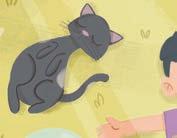







About Me


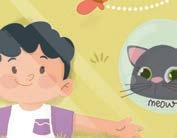








Say: story—
Hello, children. Today, you will listen to the story—First Day at School
You can use polite greetings like ‘Good morning!’, ‘How are you?’ or ‘How are you feeling today?’ to
Instruct:
Discuss some
Look at the picture on page no. 1 carefully. some of these suggested questions while pointing at the pictures.



What do you see in the picture?
2. Do you have a pet cat?
(Yes, I have a pet cat. / No, I do not have a pet cat.)
(I see a boy / a mango / a cat / a cake / a grandmother / some flowers.)
3. Do you like to eat mango?
(Yes, I like to eat mango. / No, I do not like to eat mango.)
4. Are you a boy or a girl?
(I am a boy. / I am a girl.)

Based on the learners’ responses, you may choose to ask a few follow-up questions on the

You may encourage the learners to respond to your questions and give a chance to as many learners as possible.

You may rephrase the learners’ responses into complete sentences and ask them to repeat those sentences after you. For example: I am a boy.
Listen

Listen and Enjoy 10
mins
Say: Very nice! Now, we will read a story called . It is about a boy named Neel who is learning to talk about himself. Now, let us begin reading. You may choose to play . The first read is for the purpose of enjoyment and the second read is for the explanation of the story.

First Day at School named read the story aloud or the Talking Book first
Say: Now, I will tell you what the story means. Do not forget to point at the pictures while reading or explaining the story. Pause at regular intervals and explain the meaning in the learners’ home language, if required.
You may read the story with proper pauses, voice modulation, actions and expressions to make it more interesting for the learners.












First Day at School


school.

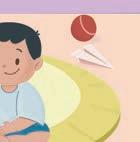
The teacher says, “Today, you will learn to say your name, age, class and school. Isn’t that good?
“Yyyaaayyy!” cheer the children.
name
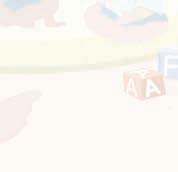
Tina smiles and says, “I am four years old.”
The teacher asks, “What is your ?” Neel learns to say, “My “Oh, wonderful!”, the teacher says. “Now tell me, what is your age?” you are in. Speak with me. I am in
“Let us learn to say which class LKG class.”












the meaning of the words and the phrase while reading the story. Associate the Meaning


Sl. no. Word Pronunciation Action school skool
on your shoulder name naym

1

a place where we go to study act to put your school bag
what people call you

point at a student’s ID card and say, ‘What do your friends call you?’
old eeuhz ohld to with your fingers
years oldeeuhz ohldto tell your age act to show number four a grade in which the child is studying
You may pause at the annotations and ask these suggested questions.
What is the name of the boy?
(The name of the boy is Neel.)
After 2
How old is Tina?
(Tina is four years old.)
class klass circular manner is
act to point at the class moving your right hand in a




After 3
What is the name of Neel’s school?
After 4

Which class is Neel in?
(Neel is in LKG class.)

(The name of Neel’s school is The Little Flowers School.)
Note: Refer to the next page for annotations 3 and 4.

Summarise




Say: In the story, we read about a boy named Neel. He learns to talk about his name, age, school and class.





“What is the name of your school? Say it loud, ‘I study in The Little Flowers School’”. Neel’s mother picks him up from school. Mother asks, “What did you learn at school today?”
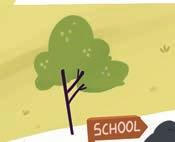
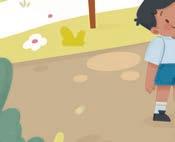




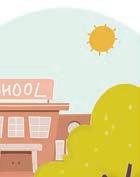
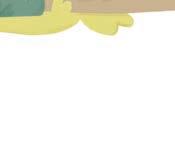
Neel clears his voice. “Aaahhheemm!”
He says, “My name is Neel. I am four years old. I am in LKG class. I study in The Little Flowers School.”






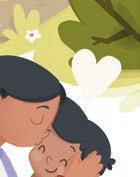








Explain
Let’s Speak

the meanings of these keywords in the learners’ home language.
Say what I say. Do what I do.
1. Instruct: school shoulder.
I go to school
Repeat 5–6 times.
2. Instruct:
Say what I say. Do what I do.
My name is Riya.
My name is Aman.
Repeat 5–6 times.

Do the action of putting your school bag on your in the morning.


Do the action of pointing at a student’s ID card.
3. Instruct: Say what I say. Do what I do. class.
We are in LKG class
Repeat 5–6 times.
Do the action of pointing at the class moving your right hand in a circular manner.



E&R
E & R Express
Ask the learners, whom you may select randomly, to speak the sentences independently.
Say:
Instruct:
Repeat



Conclusion
Now, you will tell me the sentences with these keywords. Tell me the sentence with the word ‘school’. the process for all the keywords. words E & R
Homework

Say: Today, we learnt to speak words and sentences about ourselves. We talked about our name, school, age and class. We learnt to say the words ‘school’, ‘name’ and ‘class’; and use them in sentences.
Say: Today, you will tell your parents about the words and the sentences that you learnt in the class. You will tell them about the sentences you learnt with the words ‘school’, ‘name’ and ‘class’.
Theme 1







yellow, It looks like the sun.
the colour eat
,
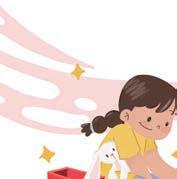

Butter, jam and bun.
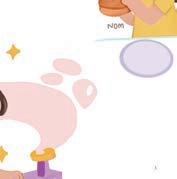





I like to catch.
play
I like to kick the ball.
I like my toy train.
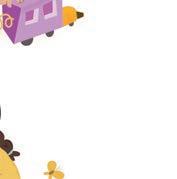
I also like my doll.

I like to draw and colour,
In my drawing book.
I like the clothes I wear,
I like the way I look.









Say: . It was
Hello, children! In the last class, we heard a story called First Day at School about a boy called Neel. We heard about Neel’s name, age, school and class. We also learnt the words ‘school’, ‘name’ and ‘class’.
You can use one of the activities given in the front matter to grab the attention of the learners and to



Say:
Instruct: Let us start.
Discuss class.

Let us have some fun! I will do some actions and you will say what they are. the keywords learnt in the previous class.






Say:
Good! That was fun!


Instruct: Now, look at the pictures on page no. 4 carefully. Discuss some of these suggested questions while pointing at the pictures.
What do you see in this picture? (I can see a girl / toys / a butterfly.)
2. What is the girl eating? (The girl is eating a burger / a bun.)
3. What is the girl playing with? (The girl is playing with a train.)

4. What is the colour of the butterfly? (The I go to school.

(The colour of the butterfly is yellow.)


Theme 1



Based on the learners’ responses, you may choose to ask a few follow-up questions on the illustrations.






Listen and Enjoy
Say: We will read a rhyme called Now, let us begin reading.
You may choose to read play the Talking Book
I Like. It is about a girl who tells us what she likes. the rhyme aloud or . The first read is for the purpose of enjoyment and the second read is for the explanation of the rhyme.
Say:
Now, I will tell you what the rhyme means.
Do not forget to point at the pictures while reading or explaining the rhyme. Pause at regular intervals / after each sentence and explain the meaning in the learners’ home
language, if required.



You may sing the rhyme in tune with proper voice modulation and hand gestures to make it interesting for the
Explain
the meaning of the words and the phrase while reading the rhyme. Associate the words with the suggested actions.
10 mins

Sl. no.WordPronunciationMeaning

1 I like I like something that you enjoy colour kuh.lr what we use to fill our drawings with eat eet to have food play play or game

Sl. no. Word Pronunciation Meaning Action


act to make a circle with your thumb and index finger and keep the other fingers straight act to hold a colour pen in your right hand and shake it from left to right act to eat using your left hand as a plate to enjoy some sport act to kick an imaginary ball with your foot
You may pause at the annotations and ask these suggested questions.
What does the girl like to eat?
(The girl likes to eat butter, jam and bun.)
What does the girl like to play?
Refer to the previous page for annotations.

Does the girl like her doll?
(Yes, the girl likes her doll.)
Where does the girl like to draw?

(The girl likes to draw in her drawing book.)



At the end of the rhyme, you may ask the learners what they like to play, what they like to do in their
In this rhyme, we read about what the little girl likes to do. The little girl likes yellow colour. She likes to eat butter, jam and bun. She likes her doll. She also likes to draw.


Explain




Let’s Speak
the meanings of these keywords in the learners’ home language.
Say what I say. Do what I do.
1. Instruct: colour. and shaking it left to right. I like pink colour. Repeat 5–6 times.
2. Instruct:
Say what I say. Do what I do.
I eat food.
I eat food every day.
Repeat 5–6 times.

Do the action of holding a colour pen in your right hand

3. Instruct: Say what I say. Do what I do. play football.

Do the action of eating using your left hand as a plate. Do the action of kicking an imaginary ball with your foot.
I play with my friends.
Repeat 5–6 times.



E&R
E & R Express
Ask the learners, whom you may select randomly, to speak the sentences independently.
Say:
Instruct:
Repeat



If time permits, you may also invite the learners to speak the sentences with the words learnt in period 1—‘school’, ‘name’ and ‘class’.
Conclusion
Now, you will tell me the sentences with these keywords. Tell me the sentence with the word ‘colour’. the process for all the keywords. them
Homework
class and and E & R
Theme 1
• About Me

Say: Today, we learnt to speak words and sentences on our likes. We talked about things that the girl likes to do. We learnt to speak the words ‘colour’, ‘eat’ and ‘play’; and use them in sentences.
Say: Today, you will tell your parents about the words and the sentences you learnt in the class and show their actions. You will tell them about the words ‘colour’, ‘eat’ and ‘play’; and use them in sentences. You may also ask them about the colour they like and game they like to play.





My friend

Me and My Friend

and me. Of the same age, We both are three. His is too.



My hair is black, We live in the city, Close to the zoo.



I love myself, And so does he. The good in us, We always see.




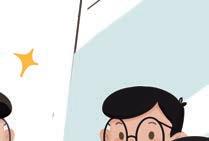











Say: I Like. It was about a girl who
Hello, children! In the last class, we heard a rhyme called tells us what she likes to eat, play, wear etc. We also learnt the words ‘colour’, ‘eat’ and ‘play’.

You may begin the class with some movements and stretching exercises to make sure that the learners are active and engaged.
Say: Let us have some fun! I will do some actions and you will say what they are.
Instruct:
Let us start.
Discuss the keywords learnt in the previous class.





I like yellow colour.
Say:
Wonderful! That was fun.

What do you see in this picture?
You may rephrase the learners’ responses into complete sentences and ask them to repeat those sentences. For example:
Instruct: Now, look at the pictures on page no. 5 carefully. Discuss some of these suggested questions while pointing at the pictures.
2.
What are the boys looking at?
(The boys are looking at the mirror.)

(I can see two boys. / I can see a mirror.)
3. Does a boy in the picture wear glasses?
(Yes, one boy wears glasses.)

(The boys are happy.)
4. Look at the boys’ faces. Are they happy or sad?






Based on the learners’ responses, you may choose to ask a few follow-up questions on the illustrations.





Listen and Enjoy

Say: We will read a rhyme called . It is about two boys who are friends and live in the city.
You may choose to read the rhyme aloud or the Talking Book. The first read is for
Me and My Friend play
the purpose of enjoyment and the second read is for the explanation of the rhyme.

You may read the rhyme with voice modulation, hand gestures and with rhythm to make it interesting for the learners.
Say:
if required.
Explain suggested actions.

Now, I will tell you what the rhyme means.
Do not forget to point at the pictures while reading or explaining the rhyme. Pause at regular intervals / after each sentence and explain the meaning in the learners’ home language, the meaning of the words while reading the poem. Associate the words with the Action



Sl. no. Word Pronunciation Meaning my friend mahy frend my mahy chest we wee
a person that you like and play with act to shake hands using both hands something that belongs to you act to put your right hand on your a group of two or more people and you are a part of the group


I love I luhv hands
act to bring both your hands to your chest and then open them outwards someone or something that you like the most act to make heart using both your
You may pause at the annotations and ask these suggested questions.
After
Where do the boy and his friend look?
(The boy and his friend look in the mirror.)

(The boys are three years old.)


Refer to the previous page for annotations.


(The boys live in a city. / The boys live close
What do the boys always see?
(The boys always see good in themselves.)

You may rephrase the learners’ responses into complete sentences and ask them to repeat those The boys are three years old.
In this rhyme, we read about two friends who live in the city. We read about their age,





Explain

Let’s Speak
the meanings of these phrases in the learners’ home language.
1. Instruct:
Say what I say. Do what I do.
my friend.
Neelu is my friend
Repeat 5–6 times.
2. Instruct:
Say what I say. Do what I do.
I love my mother.
I love my teacher.
Repeat 5–6 times.


Do the action of shaking hands using both hands.

Do the action of making a heart using both your hands.
Say what I say. Do what I do.
3. Instruct: years old fingers.
My friend is four
Do the action of showing the number four with your years old.
Repeat 5–6 times.
You may use actions of your own to help learners associate the words with those actions.
E & R Express
Ask
Say:
Instruct:


the learners, whom you may select randomly, to speak the sentences independently. Now, you will tell me the sentences with these phrases. Tell me the sentence with the phrase ‘my friend’.
Repeat
the process for all the phrases.
13 mins

E & R
E&R
If time permits, you may invite the learners to also speak the sentences with the words that were learnt in periods 1 and 2—‘school’, ‘name’, ‘class’, ‘colour’, ‘eat’ and ‘play’.
Say:
Today, we learnt to speak phrases and sentences about ourselves. We learnt to speak the phrases ‘my friend’, ‘I love’ and ‘years old’; and use them in sentences.
Homework they are.



Say: Today, you will tell your parents about the phrases and the sentences learnt in the class and show their actions. You will tell them about the phrases ‘my friend’, ‘I love’ and ‘years old’. You may also ask your parents about their friend, what they love and how old










I like yellow colour. I eat food.





I play football. Rohan is my friend. I love my mother.



About Me





I am in LKG class.



I like my friend.







Discuss

Let’s Speak
the keywords and the phrases learnt in periods 1, 2 and 3.
Say what I say. Do what I do.
1. Instruct: school. shoulder. I go to school
Do the action of putting your school bag on your in the morning.
Repeat 5–6 times.
2. Instruct:
Say what I say. Do what I do.
I eat food.
I eat food every day.



Repeat 5–6 times.
3. Instruct: my mother.
I love my teacher.
Repeat 5–6 times.
Repeat
10 mins
Do the action of eating using your left hand as a plate.
Say what I say. Do what I do.
Do the action of making a heart using both your hands. the process for all the keywords and phrases.
E & R Express
Now, I will call you, one by one, so that you can speak the sentences for the words and phrases related to yourself.
Invite as many learners as possible to say the sentences.

Say: E & R

Instruct: Tell me the sentence with the word ‘school’.
Repeat the process for all the words.
You may use the actions while speaking the words so that the learners are able to associate and recall the sentences or phrases learnt for the words.
You may praise the learners if they share sentences other than those discussed in the class.

You may praise the learners for speaking confidently and correctly. You may say ‘Good job!’, ‘Keep it up!’ or ‘Awesome!’. If the learners hesitate, you may prompt them or guide them through actions.







Say:
Now, turn to page no. 8 of your book.
Explain:
There are some pictures of myself and what I like. You have to colour the correct picture. For example: If you are a girl, you will colour the girl.
Instruct: and
Now, you will colour who you are, what you like to eat and what you like to play. You may ask these suggested questions.

Who are (I am a girl. / I am a boy.)
Who are you—a girl or a boy?



2. Do you like to fly kites? like
(Yes, I like to fly kites. / No, I do not like to fly kites.)
3. Do you like balloons? like
(Yes, I like balloons. / No, I do not like balloons.)
4. like I
What do you like to eat—an apple or a mango?

(I like to eat a mango / an apple.)
Say:





In this chapter, we learnt to say simple things about ourselves. We also learnt to speak words, phrases and sentences related to ourselves.








As a part of the theme, learners will:
• develop a basic understanding about their bodies.


• learn to say some keywords, phrases and sentences related to their bodies.


















Say: Aditi’s Adventures
Good morning, children! Today, you will listen to the story—


Instruct: Look at the picture on page no. 9 carefully. Discuss some of these suggested questions while pointing at the pictures.

What do you see in the picture?
(I see a girl / grass / road / water.)
2. Look at the girl’s hair. What is the colour of her hair?
3.
(The colour of her hair is brown / black.)
How many hands does the girl have?

(The girl has two hands.)




Based on the learners’ responses, you may choose to ask a few follow-up questions on the cover page.
You may rephrase the learners’ responses into complete sentences and ask them to repeat those sentences after you. For example: The girl has two hands.
Listen
Listen and Enjoy

Aditi’s Adventures reading.
read the story aloud or the Talking Book is
Say: That was fantastic! Now, we will read a story called . It is about a girl named Aditi. She tells us how important her eyes, mouth, nose, and ears are. Now, let us begin reading
You may choose to play . The first read is for the purpose of enjoyment and the second read is for the explanation of the story.
Say: Now, I will tell you what the story means.


Do not forget to point at the pictures while reading or explaining the story. Pause at regular intervals and explain the meaning in the learners’ home language, if required.

10 mins







Aditi’s Adventures

Aditi is a sweet little girl. She learns parts. She comes home from school. She is
Today, she learnt about body tired and she sleeps.







Aditi is on a mountain! She sees the white snow and the blue sky. Aditi says, “Wow! I can see so many things with my

Soon after, Aditi is at a shop! She eats sandwiches, idlis and sweets. Aditi says, “Yummy! I can eat so many things with my mouth.”


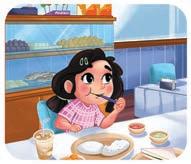







the meaning of the words while reading the story. Associate the words with the Meaning

Sl. no. Word Pronunciation Action


body bo.dee
tired tai.uhd

eyes ize point at your eyes
mouth mow.th point at your mouth
nose noze point at your nose
ears eeuhz point at your ears
our physical parts from head to toe point from your head to toe a feeling that you need to rest or sleep act to show a dull face and put your palm on your head the part of your face that you use to see the part of your face you use to speak and eat the part of your face you use to smell the part of your face that you use to hear
You may pause at the annotations and ask these suggested questions. 1

What can you see with your eyes right now?
(I can see my friends / chalks / the blackboard.)
After 2
What can Aditi do with her mouth?
(Aditi can eat with her mouth.)
After 3
What can Aditi smell with her nose?
(Aditi can smell roses and jasmine with her nose.)
After 4

What can you hear with your ears?

(I can hear my friend. / I can hear the birds.)




Note: Refer to the next page for the annotations 3 and 4.
Summarise


Say: In the story, we read about Aditi. We read that she finds out how useful her eyes, mouth, nose and ears are.







nose.”




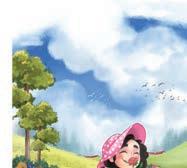



Aditi is at her home now! She hears her mother sing and the dog bark.
Aditi says, “Ohhhh! I can hear so many things with my

ears

“Get up, Aditi! Get ready to play!” says Mother.
“Was it a dream?” Aditi wonders.

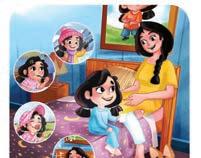




Explain




Let’s Speak
the meanings of these keywords in the learners’ home language.
1. Instruct:
Say what I say. Do what I do.
eyes.
I have two eyes.
Repeat 5–6 times.
2. Instruct: nose
Say what I say. Do what I do.
I smell with my
I have one nose.
Repeat 5–6 times.
3. Instruct: ears.


Do the action of pointing at your eyes.

Do the action of pointing at your nose.
Say what I say. Do what I do.
I have two ears
Repeat 5–6 times.

Do the action of pointing at your ears.


E & R Express
Ask
Say:

the learners, whom you may select randomly, to speak the sentences independently. Now, you will tell me the sentences with these keywords.
13 mins



Conclusion
Homework
Instruct: Tell me the sentence with the word ‘eyes’. Repeat the process for all the keywords. where
Theme 2

Say: Today, we learnt about a few of our body parts. We talked about what we can do with our eyes, nose, mouth and ears. We learnt to speak the words ‘eyes’, ‘nose’, and ‘ears’; and use them in sentences.
Say: Today, you will tell your parents about the words and the sentences related to the body parts that you learnt in the class and also show them through actions. You will tell them the sentences with ‘eyes’, ‘nose’ and ‘ears’, and also point at them to show them where they are on your body.








I Love My Body
Nod your Touch your
head, hair.


Move your neck, Side to side.



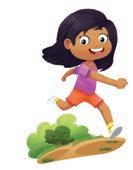
With my legs, I walk and run.
In the air.










Wave your hands,

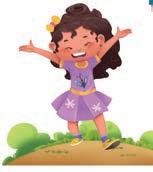


Clap your hands, Open them wide.


I love my body,
It’s so much fun.








Hello, children! In the last class, we heard a story called about a girl called Aditi. We read that she finds out how useful her eyes, mouth, nose and ears are. We also learnt the words ‘eyes’, ‘ears’ and ‘nose’.


Say: Aditi’s Adventures. It was have
Instruct:
Let us start.
Discuss the keywords learnt in the previous class.
What do you do with your eyes?
(I see with my eyes.)
2.
What do you do with your nose?
(I smell with my nose.)
3.

What do you do with your ears?
(I listen with my ears.)

Say: Let us have some fun! I will point at my body parts and you will say what I can do with them.
Say:
Very good! That was fun.
Instruct: Now, look at the pictures on page no. 12 carefully.
What do you see in the picture?
You may praise the learners for their responses and rephrase their responses into complete sentences and ask them to repeat those sentences. For example:
Discuss some of these suggested questions while pointing at the pictures.
(I see children in the picture.) the
2. What is the girl in the fifth picture doing?
(The girl is running.)

3. What do you do with your legs?

(I run / walk / jump with my legs.)

4.
What can you do with your hands?
(I can clap / write / eat with my hands.)
I see with my eyes. •


Based on the learners’ responses, you may choose to ask a few follow-up questions on the illustrations.




Listen and Enjoy

Say: We will read a rhyme called You may choose to read play the Talking Book
I Love My Body. It is about the different things that we do with our body parts. Now, let us begin reading. the rhyme aloud or . The first read is for the purpose of enjoyment and the second read is for the explanation of the rhyme. Now, I will tell you what the rhyme means.
Do not forget to point at the pictures while reading or explaining the rhyme. Pause at regular intervals / after each sentence and explain the meaning in the learners’ home


Say: and explain the meaning in the learners’ home language, if required.

You may touch the body parts you are reading about and ask the learners to copy you. This will help them to
Explain suggested actions.

the meaning of the words while reading the rhyme. Associate the words with the

no. Word Pronunciation Meaning Action head hed
the part of your body above your neck and where your hair grows hair heuh black or brown thread-like things growing on your head
10 mins
Sl. no.WordPronunciation point at your head point at your hair and act to comb it
a movement of your arm and hand hand hand
wave wayv



the part of your body using which you wave or write clap klap
to bring your hands together and make a sound legs legz
from side to side act to move your hand from side to side show your hand act to bring your hands together and make a sound point at your legs
the part of your body you use to walk or run
You may pause at the annotations and ask these suggested questions.
What do you have on your head?
What can you do with your hands?

(I can wave / write / clap with my hands.)
Note: Refer to the previous page for the annotations.
How can you move your neck?
(I can move my neck from side to side.)
What do you do with your legs?


(I walk / run with my legs.)

In this rhyme, we read about the things we do with our head, hand, neck and legs.


Explain



Let’s Speak

the meanings of these keywords in the learners’ home language.
1. Instruct: head.
Say what I say. Do what I do.
I have one head.
Repeat 5–6 times.
2. Instruct:
Say what I say. Do what I do.

Do the action of moving your head up and down.

13 mins
I clap my hands

Do the action of bringing your hands together and
I write with my hands.
Repeat 5–6 times.
making a sound.
3. Instruct: Say what I say. Do what I do. legs.
Do the action of pointing at your legs.
I run with my legs
Repeat 5–6 times.



E&R
E & R Express
Ask the learners, whom you may select randomly, to speak the sentences independently.
Say: Now, you will tell me the sentences with these keywords.
Instruct: Tell me the sentence with the word ‘hands’.
Repeat
the process for all the keywords.


You may praise the learners by saying ‘You spoke clearly.’ or ‘Well done.’ If the learners struggle, you may guide them by doing the action and asking, ‘What did I do with my head?’.

If time permits, you may also invite the learners to speak the sentences with the words learnt in period 1—‘eyes’, ‘ears’ and ‘nose’.
Conclusion
Homework
Theme 2

Say: Today, we learnt to speak about our body parts and what we do with them. We learnt to speak the words ‘head’, ‘hands’ and ‘legs’; and use them in sentences.
Say: Today, you will tell your parents about the words and sentences related to the body parts learnt in the class and show them with actions. You will tell them about the words ‘head’, ‘hands’ and ‘legs’, and also point at them to show them where they are on your body.

words




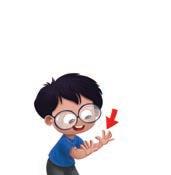


My Message to All
Ten little



Ten little toes, Two little
And one little

Two little


Two little feet, One little
With lots of teeth. Love your Big or small, Theme
fingers, eyes, nose. ears, mouth, body,















Hello, children! In the last class, we heard a rhyme called I Love My Body the things we do using our head, hands, neck and legs. We also learnt the words ‘head,
Say: . It was about ‘hands’ and ‘legs’.
You may include some exercises or actions, in between the class, to keep the learners active and
Say:
and what we do with them.
Instruct: Let us start.
Discuss



Let us play a fun game! I will point at some body parts and you will say their names the keywords learnt in the previous class.






Say:
Great! Let us read an interesting rhyme.
Instruct: Now, look at the pictures on page no. 13 carefully. Discuss some of these suggested questions while pointing at the pictures.
Who do you see in the picture?

2. (She is pointing at her eyes.)
(I see many children / boys / girls in the picture.)
What is the girl in the third picture pointing at?
3. What do you see in the eighth picture?
(I see teeth in the picture.)


Based on the learners’ responses, you may choose to ask a few follow-up questions on the illustrations.
You may compliment the learners for their responses, rephrase their responses into complete sentences and ask them to repeat those. For example: I nod my head. Theme








Listen and Enjoy
Say: We will read a rhyme called . It is about loving all your body parts. Now, let us begin reading.
You may choose to read the rhyme aloud or the Talking Book. The first read is for the
My Message to All play
purpose of enjoyment and the second read is for the explanation of the rhyme.

You may read the rhyme with voice modulation, hand gestures and in rhythm to make it interesting for the learners.
Say:
Now, I will tell you what the rhyme means.
Explain suggested actions.

10 mins
Do not forget to point at the pictures while reading or explaining the rhyme. Pause at regular intervals / after each sentence and explain the meaning in the home language, if required. the meaning of the words while reading the rhyme. Associate the words with the Actions long, thin parts of the hand that we can move show your fingers and move them
Sl. no. Word Pronunciation Meaning


1 fingers fing.guhz
toes toze
eyes ize
front part of the foot point at the front part of the foot

the part of your face that you use to see point at your eyes
nosenoze
nose noze
ears eeuhz
feet feet
teeth teeth
mouth mow.th

the part of your face which you use to smell point at your nose
the part of your face that you use to hear point at your ears
body bo.dee toe point
You may pause at the annotations and ask these suggested questions.
After


the lowest part of the leg on which we stand or walk point at your feet the part of your face using which you speak and eat point at your mouth white things inside the mouth used for eating food point at your teeth our physical parts from head to toepoint from your head to toe
How many fingers and toes do you have?

How many feet do you have?

Refer to the previous page for the annotations.

How many teeth do you have?
In this rhyme, we read about the number of fingers, toes, eyes, feet, ears, nose and mouth




Explain
Let’s Speak

the meanings of these keywords in the learners’ home language.
Say what I say. Do what I do.
1. Instruct: fingers them.
I can move my fingers.
Repeat 5–6 times.
2. Instruct: .
Say what I say. Do what I do.
I eat with my mouth
I have one mouth
Repeat 5–6 times.

Do the action of showing your fingers and moving


Do the action of pointing at your mouth.
3. Instruct: Say what I say. Do what I do. body.
I love my body.
Repeat 5–6 times.
Do the action of pointing from your head to toe.


E&R
13 mins

Ask the learners, whom you may select randomly, to speak the sentences independently.
Say: Now, you will tell me the sentences with these keywords.
Instruct: Tell me the sentence with the word ‘fingers’.
Repeat
E & R Express the process for all the keywords.

Conclusion

If time permits, you may invite the learners to also speak the sentences with the words learnt in periods 1 and 2—‘eyes’, ‘ears’, ‘nose’, ‘head’ ‘hands’ and ‘legs’.
Homework
words

Say: Today, we learnt to speak words and sentences on our body parts. We also learnt to speak the words ‘fingers’, ‘mouth’ and ‘head’; and use them in sentences.
Say: Today, you will tell your parents about the name of the body parts that you have learnt in the class and also point at them. You will tell them the sentences with ‘fingers’, ‘body’ and ‘mouth’.














I nod my head. I comb my hair. I clap my hands.



I have two legs. I have ten fingers.




• My Body














 XPRE SS
XPRE SS



Let’s Speak

Discuss learnt
the keywords learnt in periods 1, 2 and 3.
1. Instruct: body
Say what I say. Do what I do.
I love my body.
Repeat 5–6 times.
2. Instruct: .
Say what I say. Do what I do.
I listen with my ears


Do the action of pointing from your head to toe.

I have two ears
Repeat 5–6 times.
3. Instruct: hands.
Say what I say. Do what I do.
I write with my hands
Repeat 5–6 times.
Repeat
Do the action of pointing at your ears.
making a sound.
Do the action of bringing your hands together and the process for all the keywords.
E & R Express
Say: related to body parts.
Now, I will call you, one by one, so that you can speak the sentences for the keywords

Invite as many learners as possible to say the sentences.
Instruct: Tell me the sentence with the word ‘body’.
Repeat the process for all the keywords.

13 mins
E & R
You may use the actions while speaking the words so that the learners are able to associate and recall the sentences or phrases learnt for the words.
You may appreciate the learners if they share sentences other than those discussed in the class.


You may praise the learners for speaking confidently and correctly. You may say ‘Very good!’, ‘Great job!’ or ‘Fantastic!’. If learners hesitate, you may prompt them or guide them through actions.





OOSTER


Cam the Clown is white. Fill him in with colours and make
him bright!


. Colour the mouth




. Colour the nose .
orange. pink. Colour the hands blue. Colour the legs green. red.















2:38:56




Say:
Now, turn to page no. 16 of your book.
Explain: for
There are different colours given for different parts of the body. For example: You need to colour the clown’s hair orange.
Instruct:
Now, you should colour the picture. Look at the colour suggested for each body
part carefully.
You may ask these suggested questions.



What is the colour of your hair?
(My hair is brown / black in colour.)


How many eyes do you have?

2. (I have two eyes.)
3. (I have one nose.)
How many noses do you have?

4. (I have two hands.) (I have two legs.)
How many hands do you have?

How many legs do you have?





Say: In this chapter, we learnt to name the body parts, say the words related to our body, and use them correctly in sentences.








As a part of the theme, learners will:
• learn to talk about their family.


• learn to say some keywords, phrases and sentences related to family.

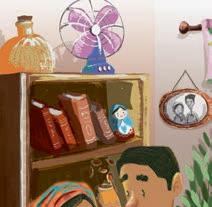




My Family



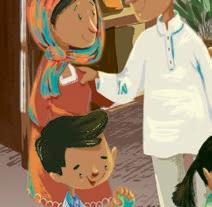


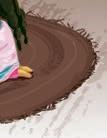




Say: Parul’s Family Album
A very good morning, children! Today, you will listen to the story—


Instruct: Look at the picture on page no. 17 carefully. Discuss some of these suggested questions while pointing at the pictures.

Let us do some counting. How many people are there in the picture?
(There are seven people in the picture.)
2. Is there a pet / pet animal in the picture?
(Yes, there is a pet animal in the picture. / Yes, there is a pet dog.)
3. Who has a ball in his hand?
3.
(The boy has a ball in his hand.)

Do you see any photos in the picture? Point and show them to me.
(Yes, I see two photos in the picture.)




Based on the learners’ responses, you may choose to ask a few follow-up questions on the cover page.
You may rephrase the learners’ responses into complete sentences and ask them to repeat those sentences after you. For example: The boy has a ball in his hand.
Listen
Listen and Enjoy


You may give a chance to as many learners as possible to respond to the questions. Also, compliment them for their efforts to respond to the questions.
10 mins

Say: Parul’s Family Album. It is about a girl named Parul. She is making her family photo album. A photo album is a book where we paste or keep different photos. Now, let us begin reading.
You may choose to play Talking Book. The first read is for the purpose of enjoyment and the second read is for the explanation of the story. Say:
Great! Now, we will read a story called read the story aloud or the is Now, I will tell you what the story means.

You may read the story with voice modulation, hand gestures and expressions to make it more interesting for your learners.


Do not forget to point at the pictures while reading or explaining the story. Pause at regular intervals and explain the meaning in the learners’ home language, if required.
You may show a poster or a photo album of a family in the class and point at the family members’ images while reading about them in the story.





Parul’s Family Album

Parul makes a family photo album!
On the first page, Parul pastes her photo. She writes below it.
On the second page, Parul pastes her mother’s photo. She writes
“MOTHER” below it.


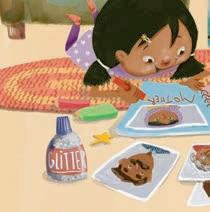

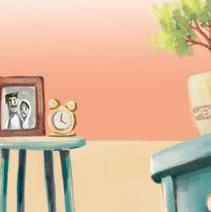







the meaning of the words and the phrase while reading the story. Associate the words and the phrase with the suggested action and suggestion.

Sl. no. Word Pronunciation

me mee
mother muh.thuh

something related to myself
a woman in your family who gave birth to you
father faa.thuh the
sister si.stuh
brother bruh.thuh
my family mai fa.muh.lee

1


Meaning Action / Suggestion
Put both your hands one over
the other on your chest
You may show the poster, photo album or flash cards of family members and point at each member when you say .thuhthe male parent a girl who has the same parents as you have a boy who has the same parents as you have people who may live together and are related to each other
You may pause at the annotations and ask these suggested questions.
What does Parul write below her photo in the photo album? (Parul writes ‘ME’ below her photo in the photo album.)
After 2

Whose photo does Parul paste on the second page? (Parul pastes the photo of her mother on the second page.)
After 3
What does Parul write on the fourth page of her photo album? (Parul writes ‘SISTER’ on the fourth page.)
After 4

What does Parul write below the family photo? (Parul writes ‘MY FAMILY’ below the family photo.)

Note: Refer to the next page for annotations 3 and 4.
Summarise


these words.




Say: In this story, we read about Parul and her family members. We learnt the names of the family members.





On the third page, Parul pastes her father’s photo. She
FATHER” below it.
On the fourth page, Parul pastes her sister’s photo. She
SISTER” below it.
“BROTHER” below it.





On the fifth page, Parul pastes her brother’s photo. She writes
On the last page, she pastes a family photo that has everyone in it. in large letters below it.
Parul says, “I love my family so much!”

She writes “MY FAMILY” •

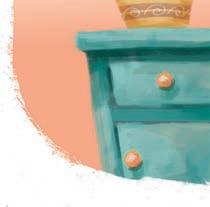
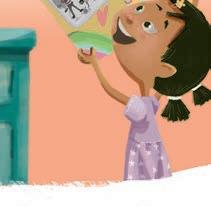






Explain
Let’s Speak

1. Instruct:
the meanings of these keywords in the learners’ home language. Say what I say. Do what I do.
My mother helps me
Repeat 5–6 times.
2. Instruct: Say what I say.
My mother cooks food.
I love my mother.
Repeat 5–6 times.
3. Instruct: Say what I say. father
My father is tall.
Repeat 5–6 times.


Do the action of putting both your hands on your chest
me. chest one over the other.



13 mins

E&R Express
Ask
Say: will
Instruct:



E & R 5 mins
the learners, whom you may select randomly, to speak the sentences independently. Now, you will tell me the sentences with these keywords. Tell me the sentence with the word ‘me’. the process for all the keywords.

Conclusion
Homework

Say: Today, we learnt to speak words and sentences on My family. We learnt the names of our family members and how to talk about them. We learnt to speak the words ‘me’, ‘mother’ and ‘father’; and use them in sentences.
Say: Today, you will tell your parents about the words and the sentences that you learnt in the class. You will tell them about the words ‘me’, ‘mother’ and ‘father’. You may do the action of pointing at yourself, your mother and your father when you say these words.

You may ask the learners questions about their mother and father. For example: What is your mother’s name? What does your father look like? Theme
Repeat words the E & R •







All Families Are Fun


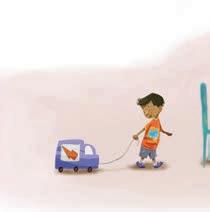
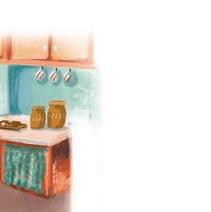



Families are people Who care about you.
Your family is too!

fathers, brothers, Grandmas and grandpas, And so many others!


is fun, Mothers and And sisters and Or far, far apart. I love my family
With all my heart.
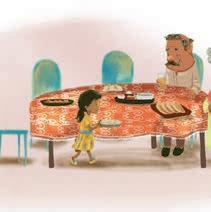






Hello, children! In the last class, we heard a story called Parul’s Family Album about a girl called Parul. We heard who are in her family. We also learnt the words ‘me’,
Say: . It was ‘mother’ and ‘father’.
You can use one of the activities given in the front matter to grab the attention of the learners and to



have members have to say who they are.
Instruct: Let us start.
Say: Let us have some fun! I will point at some pictures of the family members and you the keywords learnt in the previous class.
Discuss Wonderful! That was fun.



You may rephrase the learners’ responses into complete sentences and ask them to repeat those sentences. For example: My brother helps me.
Say:
Instruct: Now, look at the pictures on page no. 20 carefully. Discuss some of these suggested questions while pointing at the pictures.
2.
(The two ladies are in the kitchen.)

Where are the two ladies in the first picture?
Who do you think the people holding the little baby in their hands are?
3. Who are in the second picture?
(I think they are the mother and father of the little baby.)
(In the second picture, there is a grandfather, a grandmother, a boy and a girl.)
4. What is the little boy doing?

(The little boy is playing with his toy truck / toy / toy bus.)



Based on the learners’ responses, you may choose to ask a few follow-up questions on the illustrations.





Say: We will read a rhyme called You may choose to read play the Talking Book
All Families Are Fun. It is about family members who love and care for us. Family members can live near or far from us. Now, let us begin reading. the rhyme aloud or . The first read is for the purpose of enjoyment and the second read is for the explanation of the rhyme.
Say: language, if required.


Listen and Enjoy 10 mins
Now, I will tell you what the rhyme means. Do not forget to point at the pictures while reading or explaining the rhyme. Pause at regular intervals / after each sentence and explain the meaning in the learners’ home

You may read the rhyme with voice modulation, actions and in rhythm to make it interesting for the
Explain words with the illustrations.
the meaning of the words and the phrase while reading the rhyme. Associate the

Sl. no.WordPronunciation

.muh.lee
.thuhsthe male parent



You may pause at the annotations and ask these suggested questions.

Do you have fun with your family?
(Yes, I have fun with my family.)

(In my family, there is a mother, a father,
no. Word Pronunciation Meaning my family mai fa people who may live together and are related to each other mothers muh.thuhs a woman in your family who gave birth to you fathers faa.thuhs the sisters si.stuhs girls who have the same parents as you have brothers bruh.thuhs boys who have the same parents as you have a sister and a brother.)


Note: Refer to the previous page for annotations.


Do you love your family?



If the learners respond correctly, you may rephrase their responses into complete sentences and ask them to repeat those sentences. For example: If a learner says ‘yes’, you could rephrase it to ‘Yes, I love my family.

In this rhyme, we learnt about families. We learnt that families can be fun. They could



Explain



Let’s Speak

the meanings of these keywords and the phrase in the learners’ home language.
1. Instruct: Say what I say. sister and I play.

My sister eats.
Repeat 5–6 times.
2. Instruct: Say what I say.

My brother is small. plays with me.
My brother
Repeat 5–6 times.
3. Instruct: Say what I say.
my family
My family is big.
Repeat 5–6 times.
E & R Express
Ask
Say:


13 mins
the learners, whom you may select randomly, to speak the sentences independently. Now, you will tell me the sentences with these keywords and the phrase. Tell me the sentence with the word ‘sister’.
Repeat the process for all the keywords and the phrase.





If time permits, you may also invite the learners to speak the sentences with the words learnt in period 1—‘me’, ‘mother’ and ‘father’.
Conclusion
Homework

Instruct: E & R
Say: Today, you will tell your parents about the words, phrase and the sentences learnt in the class and point at the family member or pictures in the book. You will tell them about the words ‘sister’ and ‘brother’ and the phrase ‘my family’. Echo E&R
5 mins

Theme 3

Say: Today, we learnt to speak words, phrase and sentences on our family members. We learnt to speak the words ‘sister’ and ‘brother’ and the phrase ‘my family’; and use them in sentences.

2 mins







Family Get-together


Listen to me
Listen to me
sister, brother,
Let us plan a picnic
Or a get-together.


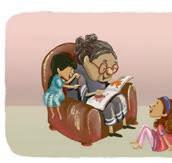
Cousin Simmi listens

To stories by Our grandfather


Father Mother Aunt Uncle grandmother, plays
With my little brother.





cooks the rice, bakes the cake. cuts the fruit, makes the shake.


Listen to me sister, Listen to me brother, Let us all have fun
In a family get-together.









Say: .
Good morning, children! In the last class, we heard a rhyme called All Families Are Fun In the rhyme, we learnt what a family is and that we all love our family. We also learnt the words ‘sister’ and ‘brother’ and the phrase ‘my family’.
You may play a fun game to grab the attention of the learners. You may do some stretching exercises
Say:
have to say who they are.
Instruct: Let us start.
Discuss



Let us have some fun! I will point at some pictures of the family members and you the keywords and phrase learnt in the previous class.






You may rephrase the learners’ responses into complete sentences and ask them to repeat those sentences. For example: I love my family.
Say:
Nice! That was fun.
Instruct: Now, look at the pictures on page no. 21 carefully. Discuss some of these suggested questions while pointing at the pictures.
How many people are there in the first picture?
(In the first picture, there are four people.)
2. Where are they standing?

(They are standing in the kitchen / in the house.)
3. Where is the grandmother sitting?
(The grandmother is sitting on the sofa.)
4. What is the grandfather doing? to

(The grandfather is showing a toy to the boy.)



Based on the learners’ responses, you may choose to ask a few follow-up questions on the illustrations.






Listen and Enjoy
Say: We will read a rhyme called
You may choose to read the rhyme aloud or the Talking Book
Family Get-together. It talks about what happens when all the members of the family are together. Now let us begin reading. play . The first read is for the purpose of enjoyment and the second read is for the explanation of the rhyme.
You may read the rhyme in rhythm and with proper voice modulation and expressions to make it interesting for the learners.
Say:

10 mins
Now, I will tell you what the rhyme means.
Do not forget to point at the pictures while reading or explaining the rhyme. Pause at regular intervals after each sentence and explain the meaning in the learners’ home language, if required.
Explain the meaning of the words while reading the poem. Associate the words with the illustrations.

Sl. no.WordPronunciation


Sl. no. Word Pronunciation Meaning
1 sister si.stuh
brother bruh.thuh
a girl who has the same parents as you have
father faa.thuh the
a boy who has the same parents as you have .thuhthe male parent
mother muh.thuh

a woman in your family who gave birth to you

aunt aant

uncle uhng.kl
grandmother grand.muh.thuh
grandfather grand.faa.thuh
a person who is the wife of your uncle
a person who is the brother of your father or mother
a person who is the mother of your father or mother
a person who is the father of your father or mother





You may pause at the annotations and ask these suggested questions.
After
Have you ever gone on a picnic with your family?
(Yes, I have gone on a picnic with my family. / No, I have not gone on a picnic.)

Who makes the shake?
(Uncle makes the shake.)


Refer to the previous page for annotations.
(Grandmother tells stories.)


You may rephrase the learners’ responses into complete sentences and ask them to repeat those sentences with you. For example: Uncle makes the shake.


What will they do in the family get-together?


In this rhyme, we read about a family get-together and the different things that the





Explain

Let’s Speak
the meanings of these keywords in the learners’ home language.
1. Instruct: Say what I say. aunt is sweet.
My aunt is tall.
Repeat 5–6 times.
2. Instruct: Say what I say.


My grandmother tells stories.
My grandmother is old.
Repeat 5–6 times.
3. Instruct: Say what I say. grandfather is fun.
My grandfather
is smart.
Repeat 5–6 times.





13 mins

You may ask some learners to tell the class what they do together with their grandparents, like, gardening, walking in a park, reading, making food etc.
E & R Express
E&R
Ask the learners, whom you may select randomly, to speak the sentences independently.
Say:
Instruct:
Repeat

Now, you will tell me the sentences with these keywords. Tell me the sentence with the word ‘aunt’. the process for all the keywords. E &
Conclusion

5 mins
Homework


Say: Today, we learnt to speak words and sentences on our families. We learnt to speak the words ‘aunt’, ‘grandmother’ and ‘grandfather’; and use them in sentences.
Say: Today, you will tell your parents about the words and the sentences learnt in the class. You will tell them about the words ‘aunt’, ‘grandmother’ and ‘grandfather’. You may also take your family photo, point at that member and tell your parents who that family member is. You may bring a family photo to the next class.
If time permits, you may also invite the learners to speak the sentences with the words and phrase that were learnt in periods 1 and 2—‘me’, ‘mother’, father’, ‘sister’, ‘brother’ and ‘my family’. Theme















gr an dmothe r






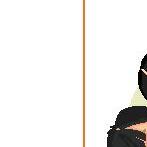


• My Family
SS

XPRE




My brother helps me. My mother cooks food.


I love my father.



My sister and I play. My brother is small.











Let’s Speak
Discuss and
the keywords and the phrases learnt in periods 1, 2 and 3.
1. Instruct: Say what I say. mother cooks food.
I love my mother
Repeat 5–6 times.
2. Instruct: Say what I say.


My sister and I play.

My sister eats.
Repeat 5–6 times.
3. Instruct: Say what I say. aunt is sweet.
My aunt is tall.
Repeat 5–6 times.
Repeat
the process for all the keywords and phrases.
E & R Express
Say:
related to your families.
Invite
Instruct:

Repeat
as many learners as possible to say the sentences. Tell me the sentence with the word ‘aunt’. the process for all the keywords and phrases.



Now, I will call you, one by one, so that you can speak the sentences for the words

You may point at the illustrations while speaking the words so that the learners are able to associate and recall the sentences or phrases learnt for the words.
13 mins
E & R

You may appreciate the learners if they share sentences other than those discussed in the class.


You may praise the learners for speaking confidently and correctly. You may say, ‘Good job!’, ‘Well done!’ or ‘Perfect!’ If the learners hesitate, you may prompt them or guide them through flash cards or illustrations.








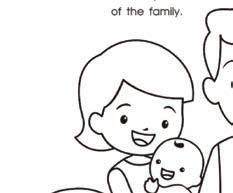









Say:



Now, turn to page no. 24 of your book.
Explain:
Instruct:
This is the family photo of Avni. There is no colour in the family photo. You have to colour the picture of Avni’s family. You may ask these suggested questions.
Do you have a younger brother?

(Yes, I have a younger brother. / No, I do not have a younger brother.)
2. Do you have a sister?


(Yes, I have a sister. / No, I do not have a sister.)
3. Do you have a pet?
(Yes, I have a pet. / No, I do not have a pet.)
4.
Avni’s mother is holding a baby. Is there a baby in your family?
(Yes, there is a small baby in my family. / No, there is no baby in my family.)
Say: family.
In this chapter, we learnt to speak words, phrases and sentences related to our











As a part of the theme, learners will:
• learn to say simple things about their school.


• learn to say some keywords, phrases and sentences related to school.






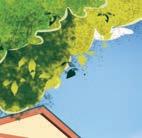




My School


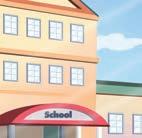
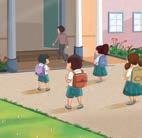







Say:



Hello children! Today, you will listen to the story—Rakhee’s School Day
You can use polite greetings like ‘Good Morning!’, ‘How are you?’, ‘How are you feeling today?’ or a theme-based question like ‘How do you come to school?’ to begin the class.
Instruct:
Discuss
Look at the picture on page no. 25 carefully. some of these suggested questions while pointing at the pictures.






Based on the learners’ responses, you may choose to ask a few follow-up questions on
the cover page.



Listen


Listen and Enjoy
read the story aloud or the Talking Book is I come to school
Rakhee’s School Day. It is about a girl
Say: Awesome! Now, we will read a story called named Rakhee. It is her first day at school. She is packing her bag for school and is happy to go to school. Now, let us begin reading.


You may choose to play . The first read is for the purpose of enjoyment and the second read is for the explanation of the story. Say: Now, I will tell you what the story means. Do not forget to point at the pictures while reading or explaining the story. Pause at regular intervals and explain the meaning in the learners’ home language, if required.





10 mins






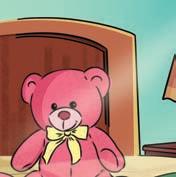

Rakhee’s School Day
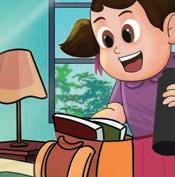



notebook.
She packs a pencil box.
school .
Today is Rakhee’s first day at . She wakes up in the school bag
What does Rakhee pack in it? and colours.
She packs her books

She also puts in her tiffin boxand water bottle.
box and water bottle.







the meaning of the words while reading the story. Associate the words with the

Sl. no.WordPronunciation


no. Word Pronunciation Meaning
school skool
a place where we read, write act to put a bag on your shoulder and walk
a bag in which we keep our books, pencils, colours, food and water bottle
school bag skool bag class
notebook note.buk
pencil box pen.suhl bawks and ruler books buks playground play.grawnd

1
point at the colourful bags in the a book that has plain paper with lines on which we write
a box in which we keep our pencils, eraser, sharpener
bundles of papers from which we read and learn
pick up any learner’s notebook and show it to the class
pick up any learner’s pencil box and show it to the class

classroom klaas.room a
What does Rakhee pack?
(Rakhee packs her school bag.)
After 2

.rooma place where we study
You may pause at the annotations and ask these suggested questions.
What does Rakhee put in her bag?

act to place your left palm forward vertically, facing upward and pretend to flip the pages of an imaginary book with your right hand
a place in school where we play with our friends act to run on the spot
act to bring both your hands near your chest on top of one another and then open them widely in a semi-circle


After 3
Does your school have a big playground? (Yes, my school has a big playground.)
After 4

(Rakhee puts a notebook, a pencil box, books, colours, tiffin box and water bottle in her bag.)
Do you listen to songs and stories in the classroom? (Yes, I listen to songs and stories in the classroom.)


You may ask the learners what they pack in their school bags. You can also ask them what they like to bring in their tiffin boxes or the number of pencils that there are in their pencil boxes.
Note: Refer to the next page for annotations 3 and 4. Summarise


Say: In the story, we read about Rakhee’s first day at school. Rakhee wakes up and packs her school bag. She wears uniform and her shoes. She eats her breakfast and leaves for school. Her school has a big and beautiful playground.





She combs her hair and wears her shoes.
After breakfast, she leaves for school.
Rakhee’s school is
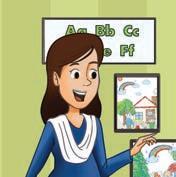
so big and beautiful.



It also has a big playground.




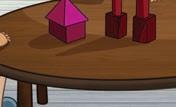


Rakhee enters the classroom with blocks and puzzles.
. There
are many children. They all listen to a story and sing a song. They also play


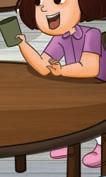

Rakhee loved her first day at school.




Explain




Let’s Speak
the meanings of these keywords in the learners’ home language.
1. Instruct:
Say what I say. Do what I do.
school bag.
My school bag is blue.
Repeat 5–6 times.
2. Instruct: notebook. class.
Say what I say. Do what I do.

Do the action of pointing at the colourful bags in the class.


Do the action of picking a notebook and showing it to the
My notebook is new.
Repeat 5–6 times.
3. Instruct: Say what I say. Do what I do.

books
books
Repeat 5–6 times.
Do the action of placing your left palm forward vertically, facing upward and pretending to flip the pages of an imaginary book with your right hand.

13 mins

E & R Express
E&R
Ask the learners, whom you may select randomly, to speak the sentences independently.
Say:
Instruct:
Repeat



Conclusion
Homework
Now, you will tell me the sentences with these keywords. Tell me the sentence with the word ‘school bag’. the process for all the keywords. that E &
Say: Today, you will tell your parents about the words and the sentences that you learnt in the class. You will tell them about the words ‘school bag’, ‘notebook’ and ‘books’. You may point at the objects or do the action while telling them about the words. E&R
5 mins
Theme 4


Say: Today, we learnt to speak words and the sentences related to school. We talked about the things we take to school and the things that are there in the school. We learnt to speak the words ‘school bag’, ‘notebook’ and ‘books’; and use them in sentences.
2 mins





School is fun,

With everyone.
See Me at School

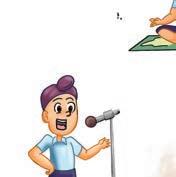




See me read,
See me write.




See my drawing Neat and bright!




See me talk,
See me play.

My teachers say ‘Have a good day!’








Good morning, children! In the last class, we heard a story called It was about a girl called Rakhee. We heard what she packs in her school bag and what happens on the first day of her school. We also learnt the words ‘school bag’, ’notebook’
Say: morning, Rakhee’s School Day and ‘books’.


Instruct:
have Let us start.
Say: Let us have some fun! I will do some actions and you will say what they are.
Discuss the keywords learnt in the previous class.



You may rephrase the learners’ responses into complete sentences and ask them to repeat those sentences. For example:
I pack my school bag.
Say:
Great! That was interesting!
Instruct: Now, look at the pictures on page no. 28 carefully.
Discuss some of these suggested questions while pointing at the pictures.
(I see a boy running.)
What do you see in the second picture?
2. What do you think the boy is doing in the fourth picture?
(The boy is reading.)
3. (The boy is writing on the board.)

What is happening in the last picture?
What is the boy writing on the board?

4. (The boy is writing ABCD / letters / the alphabet.)


Based on the learners’ responses, you may choose to ask a few follow-up questions on the illustrations.




Listen and Enjoy

Say: We will read a rhyme called does
See Me at School. It is about a boy who tells us what he does at school. Now, let us begin reading.
the rhyme aloud or
You may choose to read play the Talking Book
. The first read is for the purpose of enjoyment and the second read is for the explanation of the rhyme.
Say: Explain suggested actions.


Now, I will tell you what the rhyme means. Do not forget to point at the pictures while reading or explaining the rhyme. Pause at regular intervals / after each sentence and explain the meaning in the learners’ home language, if required.

the meaning of the words while reading the rhyme. Associate the words with the
10 mins

Sl. no.WordPronunciationMeaning

Sl. no. Word Pronunciation Meaning
run run
to move very fast using your legs
school skool a place where we read, write and learn and walk
talk tawk another person play play to enjoy some sport or game
teachers tee.chuhz someone who makes us

read reed

act to close your fists and move your hands forwards and backwards alternately act to put a bag on your shoulder
act to form the beak of a bird using your right hand and open and close it act to hit an imaginary ball with an imaginary bat
read and write in school point at yourself act to make a book using your hands, look at it and pretend to say something with
to look at words and say them your mouth
write rite to make letters or numbers on a paper with a pen or pencil movement

act to hold a pen in your right hand and move it on your left palm in a zigzag
You may pause at the annotations and ask these suggested questions.



What do the teachers say?


(The teachers say, “Have a good day”.)
What is the boy’s drawing like?

(The boy’s drawing is neat and bright.)

(I play run and catch / hide-and-seek / football / cricket.)
Note: Refer to the previous page for annotations.
If the learners respond in their home language, you may guide them with the correct word in English, rephrase their responses into complete sentences and ask them to repeat the sentences.
In this rhyme, we read about what the boy does at school.



Explain




Let’s Speak
the meanings of these keywords in the learners’ home language.
Say what I say. Do what I do.
1. Instruct: school. walking. I go to school
Do the action of putting a bag on your shoulder and in the morning.
Repeat 5–6 times.
Say what I say. Do what I do.
2. Instruct: say I read numbers.



13 mins
I read books. Do the action of making a book using both your hands, looking at it and pretending to say something with your mouth.
Repeat 5–6 times.
Say what I say. Do what I do.
Repeat 5–6 times.
3. Instruct: write. and I write letters.
Do the action of holding a pen in your right hand and moving it on your left palm in a zigzag movement.
E & R Express
Ask
Say:
Instruct: E & R
the learners, whom you may select randomly, to speak the sentences independently. Now, you will tell me the sentences with these keywords. Tell me the sentence with the word ‘write’.


5 mins
Repeat the process for all the keywords.
You may praise the learners for speaking confidently and correctly. You may say ‘Well said!’, ‘You were clear!’ or ‘Great!’. If the learners hesitate, you may prompt them or guide them through actions.

Conclusion
Homework
If time permits, you may also invite the learners to speak the sentences with the words learnt in period 1—‘school bag’, ‘notebook’ and ‘books’.
Say: Today, we learnt to speak words and the sentences related to school. We talked about the things we do at school. We learnt to speak the words ‘school’, ‘read’ and ‘write’; and use them in sentences.


Say: Today, you will tell your parents about the words and the sentences learnt in the class. You will also show their actions. You will tell them about the words ‘school’, ‘read’ and ‘write’.
Theme 4








classroom,

Make new things
My Happy Classroom


With colourful clay.

Numbers we learn, Poems we sing. Stories we hear,
And colours we bring!

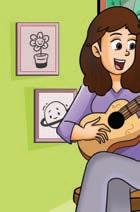
My teacher is lovely!
So are my friends.

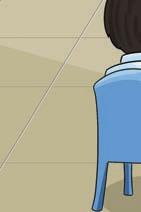
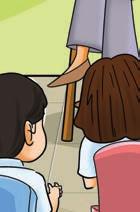






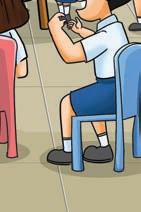







Say:
Hello, children! In the last class, you heard a rhyme called about a boy who tells us what he does at school. We also learnt the new words ‘school’,


Say: Let us have some fun! I will do some actions and you will say what they are.
Instruct:
See Me at School. It was ‘read’ and ‘write’. Let us start.
Discuss the keywords learnt in the previous class.







You may rephrase the learners’ responses into complete sentences and ask them to repeat those sentences. For example: Yes, I write.
Say:
Wonderful! That was fun!
Instruct: Now, look at the pictures on page no. 29 carefully. Discuss some of these suggested questions while pointing at the pictures.
What do you see in the picture?
(I see a teacher playing a guitar. / I see children singing.)
Do you have music class at school?
2. (Yes, I have music class at school. / No, I do not have music class at school.)
3. Let us do some counting. How many children are there?
(There are five children.)


Based on the learners’ responses, you may choose to ask a few follow-up questions on the illustrations.






Listen and Enjoy

Say: We will read a rhyme called . It is about what children do in their classroom. Now, let us begin reading.
You may choose to read the rhyme aloud or the Talking Book. The first read is for the
My Happy Classroom play
purpose of enjoyment and the second read is for the explanation of the rhyme.

You may read the rhyme with voice modulation, hand gestures and in rhyme to make it interesting for the learners.
Say:
Now, I will tell you what the rhyme means.
language, if required.
Explain suggested actions.

10 mins
Do not forget to point at the pictures while reading or explaining the rhyme. Pause at regular intervals / after each sentence and explain the meaning in the learners’ home the meaning of the words while reading the poem. Associate the words with the Action

Sl. no. Word Pronunciation

classroom klaas.room a numbers nuhm.buhz digits
.rooma place where we study
.buhzdigits 1, 2, 3, 4, 5, 6…

act to bring both your hands near your chest on top of one another and then open them widely in semicircle
act to show 1, 2, 3, 4, 5 with your fingers
colours kuh.lrz

something that is used to fill our drawings and make it colourful
teacher tee.chuh someone who makes us read and write in school After
You may pause at the annotations and ask these suggested questions.
(‘We’ make new things with colourful clay.)

point at the colour pencils or crayons in the classroom
point at yourself

Do you bring colours to the classroom? (Yes, I bring colours to the classroom.)

(‘We’ sing poems.)

Refer to the previous page for annotations.
Do you enjoy in the class with your friends? (Yes, I enjoy in the class with my friends.)
You may rephrase the learners’ responses into complete sentences and ask them to repeat those ‘We’ sing poems.
In this rhyme, we read about the things that children do in their classroom. The children make new things, learn numbers, sing poems, hear stories and have fun with their friends in





Explain

Let’s Speak
the meanings of these keywords in the learners’ home language.
1. Instruct:
Say what I say. Do what I do.
classroom is big. semicircle. I sit in the classroom.
Repeat 5–6 times.
2. Instruct: Say what I say. teacher sings rhymes. My teacher is tall.
Repeat 5–6 times.

Do the action of bringing both your hands near your chest on top of one another and then opening them widely in

3. Instruct: Say what I say. Do what I do. colours
I like blue and pink colours.
13 mins





Do the action of pointing at the colour pencils or crayons in the classroom.



Repeat 5–6 times. E & R Express
E&R
Ask the learners, whom you may select randomly, to speak the sentences independently.
Say: Now, you will tell me the sentences with these keywords.
Instruct: Tell me the sentence with the word ‘classroom’.
Repeat
the process for all the keywords.
Conclusion


If time permits, you may also invite the learners to speak the sentences with the words that were learnt in periods 1 and 2—‘school bag’, ‘notebook’, ‘books’, ‘school’, ‘read’ and ‘write’.
5 mins
Homework

Say: Today, we learnt to speak words and sentences related to the classroom. We learn numbers, sing poems and hear stories in the classroom. We learnt to speak the words ‘classroom’, ‘colours’ and ‘teacher’; and use them in sentences.
Say: Today, you will tell your parents about the words and the sentences learnt in the class. You will tell them about the words ‘classroom’, ‘colours’ and ‘teacher’.












































 XPRE SS
XPRE SS



Let’s Speak

Discuss learnt
the keywords learnt in periods 1, 2 and 3.
1. Instruct: books.
Say what I say. Do what I do.
I read books
5–6 times.
2. Instruct: write.

Say what I say. Do what I do.

Do the action of placing your left palm forward vertically, facing upward and pretending to flip the pages of an imaginary book with your right hand.

I write letters.
Repeat 5–6 times.
3. Instruct: Say what I say.
teacher
sings rhymes.
My teacher is tall.
Repeat 5–6 times.
Repeat
the process for all the keywords.
E & R Express
Say: related to the school.

Do the action of holding a pen in your right hand and moving it on your left palm in a zigzag movement.


Now, I will call you, one by one, so that you can speak the sentences for the words
Invite as many learners as possible to say the sentences.
Instruct: Tell me the sentence with the word ‘classroom’.
Repeat the process for all the keywords.

13 mins
E & R
You may use the actions while speaking the words so that the learners are able to associate and recall the sentences or phrases learnt for the words.

You may appreciate the learners if they share sentences other than those discussed in the class.


You may praise the learners for speaking confidently and correctly. You may say ‘Very good!’, ‘Well done!’ or ‘You spoke nicely!’. If learners hesitate, you may prompt them or guide them through actions.





Say:
Now, turn to page no. 32 of your book.
Explain: pictures
There are some pictures given. You have to look at them and say which things you see at school and then colour them. For example: Do you see a book at school? If yes,
then colour the book.
Instruct: and
Now, look at the pictures and colour those that you see in the school. You may ask these suggested questions.




Say:
In this chapter, we learnt to speak words and sentences related to our school.











As a part of the theme, learners will:
• learn about good habits.


• learn to say some keywords, phrases and sentences related to good habits.



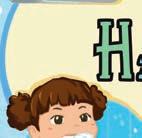



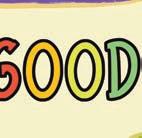















Say: Hello, children! Today, you will listen to the story—
The Little Copy Cat


Instruct: Look at the picture on page no. 33 carefully. Discuss some of these suggested questions while pointing at the pictures.

What do you see in the picture?
(I see a girl brushing her teeth. / I see a boy washing his hands. / I see a boy doing his homework. / I see a boy throwing garbage in the dustbin. / I see a girl exercising.)
2. Do you throw chocolate wrappers in the dustbin?
(Yes, I throw chocolate wrappers in the dustbin.)
3. Do you exercise daily?
3. (Yes, I exercise daily. / No, I exercise sometimes.)


4. Do you take a bath after coming back from the park?

(Yes, I take a bath after coming back from the park. / No, I wash my hands, feet and face after coming back from the park.)



Based on the learners’ responses, you may choose to ask a few follow-up questions on the cover page.


Listen

Listen and Enjoy
The Little Copy Cat
You may ask the learners if they also like to do what their elder brother or/and sister do.
read the story aloud or the Talking Book is Yes, I exercise daily.
Say: Excellent! Now, we will read a story called . It is about a brother and sister, Aman and Arya. Arya copies everything that Aman does. Now, let us begin reading.

You may choose to play . The first read is for the purpose of enjoyment and the second read is for the explanation of the story. Say: Now, I will tell you what the story means.


Do not forget to point at the pictures while reading or explaining the story. Pause at regular intervals and explain the meaning in the learners’ home language, if required.
You may read the story with voice modulation, hand gestures and expressions to make it more interesting for your learners.


10 mins




The Little Copy Cat

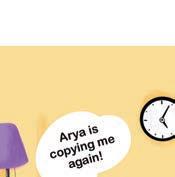
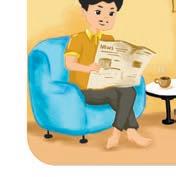

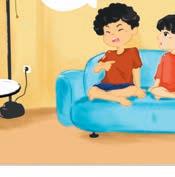

Aman lives with his father, mother and little sister, Arya. Arya loves to copy what Aman does.

“Father! Arya is copying me again!” shouts Aman.
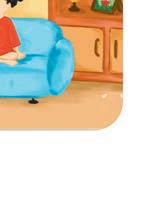
Father laughs. “You are her big brother. She will copy everything you do. You should have good habits only. She will copy that from you.”
Aman thinks of all the good things he can do.



Aman cleans his study table. Arya also cleans her study table.







the meaning of the words and the phrase while reading the story. Associate the

Sl. no.WordPronunciation

1 copy .pee good habits gud ha.buhts to cleans kleenz reads reedz them throws throze

no. Word Pronunciation Meaning
to do something exactly like the other person is doing
.buhtsto do good things daily

ask the learners to do exactly what you are doing
point at the cover page or show flash cards of good habits to remove dirt from something act to clean a table with an imaginary cloth
to look at words and say act to make a book using your hands, look at it and pretend to say something with your mouth
to send something from your hand to a place at a distance
You may pause at the annotations and ask these suggested questions.

What does Arya love to do?
(Arya loves to copy Aman. / Arya loves to copy what Aman does.)
After
What is the first good thing that Aman does?
(Aman cleans his study table.)
After
Where does Aman throw the dry leaves? (Aman throws the dry leaves in the dustbin.)
After


Do you watch TV while eating dinner?


act to hold something in your hand, bring it forward with a force and open your hand


Note: Refer to the next page for annotations 3 and 4.
Summarise

(No, I do not watch TV while eating dinner. / Yes, I watch TV while eating dinner.)


Say: In this story, we read about all the good things that Aman does and how his sister Arya copies him. Theme




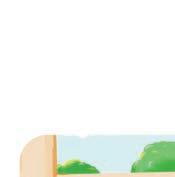

reads Aman throws
his school book. Arya also tries to read her the dry leaves and the mud in the dustbin.
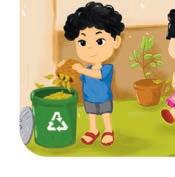



Arya says, “Goodnight, my big brother cat.”




Aman turns off the TV while eating dinner. Arya eats her dinner quietly too.
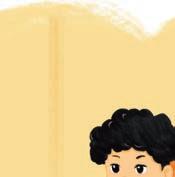



Aman hugs his sister and says “Goodnight, my little copycat.”




Explain




Let’s Speak
the meanings of these keywords in the learners’ home language.
1. Instruct:
Say what I say. Do what I do.
clean my room.
I clean the table.
Repeat 5–6 times.
2. Instruct:
read storybooks.
I read numbers.
Repeat 5–6 times.
Say what I say. Do what I do.

Do the action of cleaning a table with an imaginary cloth.


Do the action of making a book using your hands, look at it and pretend to say something with your mouth.
3. Instruct: Say what I say. Do what I do.

13 mins
Do the action of holding something in your hand, bringing it forward with a force and opening your
throw waste in the dustbin.
throw waste. with your hand.
Repeat 5–6 times.


E&R
E & R Express
Ask the learners, whom you may select randomly, to speak the sentences independently.
Say:
Instruct:
Now, you will tell me the sentences with these keywords. Tell me the sentence with the word ‘clean’.
Repeat
the process for all the keywords.



Conclusion
5 mins
Homework
Say: Today, you will tell your parents about the words, the phrase and the sentences that you learnt in the class and show their actions. You will tell them about the words ‘clean’, ‘read’ and ‘throw’. E&R
Theme 5
• Good Habits


Say: Today, we learnt to speak words, phrases and the sentences on good habits. We read about the good things Aman does and how his sister copies everything that he does. He cleans his table. He reads his school book. He throws dry leaves in the dustbin. He turns off the TV while eating dinner. We learnt to speak the words ‘clean’, ‘read’ and ‘throw’; and use them in sentences.
2 mins







Brush your teeth, Make them white.




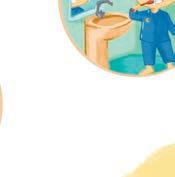




Wash your hands, With water and soap. Pray to God And ask for hope. .
Always eat Healthy food exercise
Do
In a happy mood.


Early to bed and Early to rise; Follow these habits, Be healthy and wise!
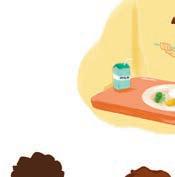













Hello, children! In the last class, we heard a story called about Aman and his sister, Arya. Aman does good things like cleaning his table. Arya copies Aman and learns good habits. We also learnt the words ‘clean’, ‘read’ and
Say: The Little Copy Cat. It was learns ‘throw’.



Instruct:
have Let us start.
Say: Let us have some fun! I will do some actions and you will say what I am doing.
Discuss the keywords learnt in the previous class.







You may rephrase the learners’ responses into complete sentences and ask them to repeat those sentences after you. For example: I throw waste.
Say:
Brilliant! That was fun.
Instruct: Now, look at the pictures on page no. 36 carefully. Discuss some of these suggested questions while pointing at the pictures.
2.
(The boy is brushing his teeth.)
Do you brush your teeth daily?
(Yes, I brush my teeth daily.)
What is the boy doing in the first picture?
3. What are the boys doing in the last picture?
(The boys are playing with a ball in the last picture.)
Do you also play in the park?
4. (Yes, I play in the park. / No, I do not play in the park.)
(Yes,


Theme 5


Based on the learners’ responses, you may choose to ask a few follow-up questions on the illustrations.




Listen and Enjoy

Say: We will read a rhyme called
Healthy Habits. It is about a boy who tells us about some healthy habits. Healthy habits are the good things that we do daily to stay fit and healthy.
Now, let us begin reading.
You may choose to read play the Talking Book
the rhyme aloud or . The first read is for the purpose of enjoyment and the second read is for the explanation of the rhyme.
Say:


Now, I will tell you what the rhyme means. Do not forget to point at the pictures while reading or explaining the rhyme. Pause at regular intervals / after each sentence and explain the meaning in the learners’ home language, if required.
You may read the rhyme with voice modulation, hand gestures and in rhythm to make it interesting for the learners.
Explain

10 mins
the meaning of the words and the phrase while reading the rhyme. Associate the words and the phrase with the suggested actions and suggestion.
Sl. no. Word Pronunciation Meaning brush bruhsh


wash vawsh
pray pray

Sl. no.WordPronunciationMeaning Action / Suggestion to clean one’s teeth using a toothbrush act to brush your teeth using your index finger to remove dirt from something by using soap and water act to rub and clean your hands back and front and pretend to wash them to ask or thank God for something act to pray by closing your eyes food that keeps us fit and energetic show flash cards or charts of healthy food
healthy food hel.thee food items

exercise ek.suh.size activity that makes us healthy and strong act to raise your right hand, put your left hand on your waist and bend towards the left
You may pause at the annotations and ask these suggested questions.

What does the boy do after waking up?
What should we wash our hands with?


(We should wash our hands with water
Refer to the previous page for annotations.


(We should always eat healthy food.)




Summarise
Say: In this rhyme, we read about the healthy habits that we should follow to be healthy


Explain




Let’s Speak
the meanings of these keywords in the learners’ home language.
1. Instruct:
Say what I say. Do what I do.
brush my teeth.
I brush
Do the action of brushing your teeth using your my teeth in the morning.
index finger.
Repeat 5–6 times.
2. Instruct:
Say what I say. Do what I do.


13 mins

I wash
Repeat 5–6 times.
3. Instruct:
Say what I say. Do what I do.
exercise every day
I exercise at school.
Repeat 5–6 times.
I wash my hands. Do the action of rubbing and cleaning your hands back and front and pretending to wash them. my hands with soap.
Do the action of raising your right hand, putting your left hand on your waist and bending towards the left.
You may show proper steps for brushing our teeth and washing our hands.
You may show different exercises that the learners could do at school or at home.



E & R Express
Ask
Say:
Instruct:
Repeat
the learners, whom you may select randomly, to speak the sentences independently. Now, you will tell me the sentences with these keywords. Tell me the sentence with the word ‘brush’. the process for all the keywords.
You may praise the learners for speaking confidently and correctly. You may say ‘Great work’, ‘Good job’ or ‘Fantastic!’. If the learners hesitate, you may prompt them or guide them through actions.


If time permits, you may also invite the learners to speak the sentences with the words learnt in period 1—‘clean’, ‘read’ and ‘throw’.

E & R
5 mins
Say: words
Homework
Today, we learnt to speak words and the sentences on good habits. We learnt to speak the words ‘brush’, ‘wash’ and ‘exercise’; and use them in sentences.
Say: ‘wash’ and ‘exercise’.
• Good Habits

Today, you will tell your parents about the words and the sentences learnt in the class. You will also show the actions of those words. You will tell them about the words ‘brush’,





Say sorry
Be Nice and Polite


In a world so sweet and bright, We should be nice and polite. , when you do wrong, This way friendship will be strong. Say , when one is kind, In this way, new friends we find. You say , when in need, Let’s always do a good deed.
sorry

thank you please


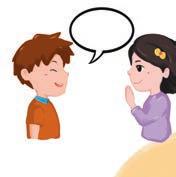

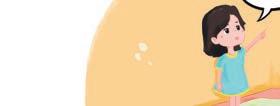






In a world so sweet and bright, We should be nice and polite.








Say: .
Good morning, children! In the last class, we heard a rhyme called Healthy Habits It was about the healthy habits that we should do daily like brushing our teeth, eating healthy food, exercising and sleeping and waking up early. We also learnt the new words
‘brush’, ‘wash’ and ‘exercise’.
You may include some exercises or actions, between the class, to keep the learners active and engaged.
Say:
Instruct: Let us start.



Discuss

Let us have some fun! I will do some actions and you will say what I am doing. the keywords learnt in the previous class.




You may rephrase the learners’ responses into complete sentences and ask them to repeat those I brush my teeth.
2.
Wonderful! That was fun (The girl looks sad.)
Now, look at the pictures on page no. 37 carefully. some of these suggested questions while pointing at the pictures.
Look at the girl’s face in the first picture. Does she look happy or sad?


Does the girl look happy in the second picture?
(Yes, the girl looks happy.)

4. What do you say to someone who helps you?
3. (I say, ‘thank you’.)
What do you think the girl is pointing at in the last picture? (The girl is pointing at a toy. / The girl is pointing at a teddy bear.)



Based on the learners’ responses, you may choose to ask a few follow-up questions on






Listen and Enjoy

Say: We will read a rhyme called
You may choose to read play the Talking Book
Be Nice and Polite. The rhyme talks about how we should always talk to others nicely and with a smile. Now let us begin reading. the rhyme aloud or . The first read is for the purpose of enjoyment and the second read is for the explanation of the rhyme.
You may read the rhyme with voice modulation, hand gestures and in tune to make it interesting for the learners. You may stress on the polite greetings for the learners to identify them in the rhyme.


10 mins
Say: language, if required.

Now, I will tell you what the rhyme means.
Do not forget to point at the pictures while reading or explaining the rhyme. Pause at regular intervals / after each sentence and explain the meaning in the learners’ home
the meaning of the words while reading the poem. Associate the words with the suggested actions and suggestion.
Explain no. Word Pronunciation Action / Suggestion

Sl. no.WordPronunciation

sorry saw.ree this word is used when you have done something wrong and you feel bad about it
thank youthang.kyoo
you thang.kyoo who has helped us or was kind to us


kind ka.ind to be nice please pleez a word that is used when you
You may pause at the annotations and ask these suggested questions.

What should we say when we do wrong?
(We should say ‘sorry’ when we do wrong.)
What should we say when someone is kind?
(We should say ‘thank you’ when someone is

Refer to the previous page for annotations.

act to hold your ears with both your hands and look sad
act to fold your hands in a namaste pose and bend your head a little
show flash cards of people helping others act to join your hands and interlock the fingers
After




What should we say when we are in need?
(We should say ‘please’ when we are in
How should we always be?
(We should always be nice and polite.)


You may rephrase the learners’ responses into complete sentences and ask them to repeat those sentences after you. For example: We say sorry when we do wrong.
You may ask the learners about the time they said ‘sorry’ or ‘thank you’ to someone. Appreciate them for using the polite greetings.

In this rhyme, we learnt that we should always be nice and polite.




Explain
Let’s Speak

the meanings of these keywords in the learners’ home language.
1. Instruct: sorry.
Say what I say. Do what I do.
I am sorry mom.
Repeat 5–6 times.
2. Instruct:
Say what I say. Do what I do.

13 mins
Do the action of holding your ears with both your hands.


bending your head. Thank you for the gift.
Repeat 5–6 times.
3. Instruct: Say what I say. Do what I do. help me.
Please help me with my homework.
Thank you for your help. Do the action of folding your hands in namaste pose and Do the action of joining the hands and interlocking the fingers.



Repeat 5–6 times. E & R Express
E&R
Ask the learners, whom you may select randomly, to speak the sentences independently.
Say: Now, you will tell me the sentences with these keywords.
Instruct: Tell me the sentence with the word ‘sorry’.
Repeat
the process for all the keywords.

Conclusion

If time permits, you may also invite the learners to speak the sentences with the words that were learnt in periods 1 and 2—‘clean’, ‘read’, ‘throw’, ‘brush’, ‘wash’ and ‘exercise’.
5 mins
Homework
Theme 5

Say: Today, we learnt to speak words and sentences on good habits. We learnt that we should always be nice and polite. We learnt to speak the words ‘sorry’, ‘thank you’, and ‘please’; and use them in sentences.
Say: Today, you will tell your parents about the words and the sentences learnt in the class and show their actions. You will tell them about the words ‘sorry’, ‘thank you’ and ‘please’. You should try to use these polite words at home with your family members.






Let’s Speak
Discuss learnt
the keywords learnt in periods 1, 2 and 3.
1. Instruct:
Say what I say. Do what I do.
clean my room.
I clean the table.
Repeat 5–6 times.
2. Instruct:

Do the action of cleaning a table with an imaginary cloth.
Say what I say. Do what I do.


I wash my hands. Do the action of rubbing and cleaning your hands back and front and pretending to wash them. my hands with soap.
I wash
Repeat 5–6 times.
Say what I say. Do what I do.
3. Instruct: help me. the fingers.
Please
Repeat 5–6 times.
Repeat
Say:
Do the action of joining the hands and interlocking help me with my homework.
the process for all the keywords.
E & R Express
Now, I will call you, one by one, so that you can speak the sentences for the words
related to good habits.
Invite
as many learners as possible to say the sentences.

Instruct: Tell me the sentence with the word ‘please’. Repeat the process for all the keywords.

13 mins
E & R
You may use the actions while speaking the words so that the learners are able to associate and recall the sentences or phrases learnt for the words.

You may appreciate the learners if they share sentences other than those discussed in the class.


You may praise the learners for speaking confidently and correctly. You may say ‘You were polite!’, ‘Well done!’ or ‘Nice!’. If learners hesitate, you may prompt them or guide them through actions.
Theme 5


Say:



Now, turn to page no. 40 of your book.
Explain: follow.
There are some good habits that we should follow and bad habits that we should not follow. You have to tick the good habits and cross the bad habits. For example: Brushing your teeth is a good habit, so you will put a tick.
Instruct:
Now, tick the good habits and cross the bad habits. You may ask these suggested questions.




(Yes, I clean my room. / No, I do not clean my room.)
Do you keep the books in their place after reading them at school?
(Yes, I keep the books in their place after reading them.)
Is it a good habit to shout in school?
(No, it is not a good habit to shout in school.)
Where should we throw the ice-cream wrappers?
(We should throw the ice-cream wrappers in the dustbin.)

Do you like to play in the park?
(Yes, I like to play in the park.)
Do you clean your room? 2. 3. school.) 4. habits.





Say: In this chapter, we learnt to speak words, phrases and sentences related to good







As a part of the theme, learners will:
• talk about different food items and the time when they eat food.


• learn to say some keywords, phrases and sentences related to food.













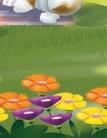


Say:



Good morning, little champions. Today, you will listen to the story—
Hungry Heena.


Instruct: Look at the picture on page no. 41 carefully. Discuss some of these suggested questions while pointing at the pictures.

What do you see in the picture?
(I see some children eating food. / I see a dog. / I see food on the plates. / I see
sandwiches on a plate.)
2.
Are there fruits on the plates?
(Yes, there are fruits on the plates.)
3.
3. Which fruit do you like to eat—apples, grapes, mangoes or papayas?

4 Do you like to eat sandwiches?

(I like to eat apples. / I like to eat papayas.)
4. (Yes, I like to eat sandwiches. / No, I do not like to eat sandwiches.)



Based on the learners’ responses, you may choose to ask a few follow-up questions on the cover page.


Yes, I like to eat sandwiches.

Listen
Listen and Enjoy

Say: Hungry Heena
Heena. She feels hungry and her grandfather makes lunch for her. Now, let us begin reading.
You may choose to
Talking Book purpose of enjoyment and the second read is for the explanation of the story. Say:
Brilliant! Now, we will read a story called . It is about a girl named read the story aloud or play the . The first read is for the Now, I will tell you what the story means.
Do not forget to point at the pictures while reading or explaining the story. Pause at regular intervals and explain the meaning in the learners’ home language, if required.


You may modulate your voice for reading Heena and her grandfather’s dialogue. This will make reading and listening to the story a fun activity.



10 mins




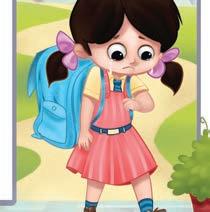


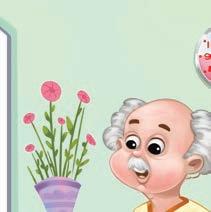
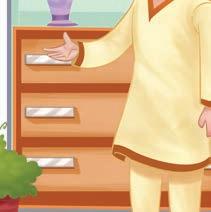


hungry!
Heena comes back from school. Oh, she is really Heena calls for her mother. “Mother! Mother! Where are you?”
There is no answer. Heena feels sad.
Just then, her grandfather enters. He asks, “Why are you sad, my







the meaning of the words while reading the story. Associate the words with the Meaning



Sl. no. Word Pronunciation Action / Suggestion .gree food act to put your hand on your eat eet a plate cook kuk rice raa.is

hungry huhng when you really want to eat stomach and move it in circles to have food act to eat using your left hand as to make the food for eating act to hold an imaginary ladle in your right hand and stir food a kind of grain which is small and white parts of plant that we cook and eat as food

1

show flash card of rice vegetables veji.tuh.blz
You may pause at the annotations and ask these suggested questions.
How Is Heena feeling after she comes back from school? (Heena feels hungry after she comes back from school.)

After 2
show flash cards of different vegetables does


How does Heena feel when there is no answer from her mother? (Heena feels sad.)
After 3
What does Heena want to do? (Heena wants to eat something.)
After 4

What will grandfather make for Heena?

(Grandfather will make curd rice and a bowl of vegetables for Heena.)
Note: Refer to the next page for annotations 3 and 4.
Summarise


Say: In this story, we read that when Heena comes back from school, she is hungry. But she can’t find her mother. So, her grandfather makes her a tasty lunch of curd rice and a bowl of vegetables.
You may ask the learners what they like to eat when they go home from school and who cooks it for them.









eat. But I can’t find Mother”
“Can I cook something for you?” asks grandfather.
“What? Really? Can you cook lunch for me?”








vegetables
rice and a bowl of ?”

“Wow! Yes please, grandfather! Hurry! Hurry!” Heena jumps with joy!
“Give me ten minutes.” says grandfather and goes into the kitchen.





Explain




Let’s Speak

the meanings of these keywords in the learners’ home language.
Say what I say. Do what I do.
1. Instruct: hungry. moving it in circles. We all are hungry.
Repeat 5–6 times.
2. Instruct: cooks food.
Say what I say. Do what I do.

Do the action of putting your hand on your stomach and


13 mins
My father cooks food for me.
Repeat 5–6 times.
3. Instruct: Say what I say. are good.
Do the action of holding an imaginary ladle in your right hand and stirring the food.
Show flash cards of different vegetables.
I eat vegetables.
Repeat 5–6 times.


E&R
Say: Now, you will tell me the sentences with these keywords. Instruct: Tell me the sentence with the word ‘hungry’.
Repeat
Conclusion
Homework


Ask the learners, whom you may select randomly, to speak the sentences independently.
Say: Today, we learnt to speak words and the sentences on food. We read a story about Heena who comes back from school feeling hungry, and her grandfather cooks food for her. We learnt to speak the words ‘hungry’, ‘cooks’ and ‘vegetables’; and use them in sentences.
E & R Express the process for all the keywords. that
E&R Theme
5 mins
2 mins


Say: Today, you will tell your parents about the words and the sentences that you learnt in the class. Tell them about the words ‘hungry’, ‘cooks’ and ‘vegetables’.



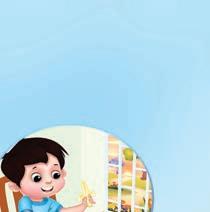
Breakfast, Lunch, Dinner
Wow, so yummy!
Every single day, I eat good
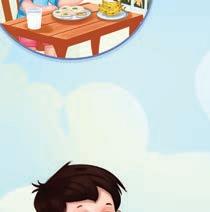


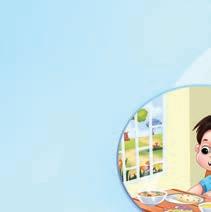





At night, it’s Healthy and light, Food makes me Fit and bright!

To study and play! in the morning, at noon, I eat my food With my spoon.
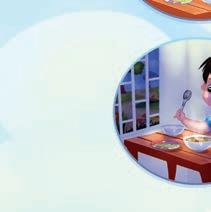
food, dinner







Hello, children! In the last class, we heard a story called about a girl called Heena. When she came back from school, she was hungry. Then, her grandfather cooked curd rice and a bowl of vegetables for her. We also learnt the words
Say: Hungry Heena. It was her. ‘hungry’, ‘cooks’ and ‘vegetables’.


Say: Let us have some fun! I will do some actions or show some flash cards and you will say what they are.
Instruct:
Let us start.
Discuss the keywords learnt in the previous class.






Say:


Great! That was fun.
Instruct: Now, look at the pictures on page no. 44 carefully. Discuss some of these suggested questions while pointing at the pictures.
What is the boy doing in the first picture?
(The boy is eating food / a banana. / The boy is eating breakfast.)
What do you eat for breakfast?
2. (I eat a paratha / bread and butter / fruits and sandwiches.)
3. Can you name the different items of food shown in the second picture? (Roti / chapati, dal, vegetables and salad.)
What do you eat for lunch?
4. (I eat dal and roti / dal and rice / dal, rice and vegetables.)


You may rephrase the learners’ responses into complete sentences and ask them to repeat those sentences. For example: My mother cooks food. Theme


Based on the learners’ responses, you may choose to ask a few follow-up questions on the illustrations.




Listen and Enjoy

Say: We will read a rhyme called
Breakfast, Lunch, Dinner. It is about a boy who tells us at what time of the day he eats his food. Now, let us begin reading.
You may choose to read play the Talking Book
the rhyme aloud or . The first read is for the purpose of enjoyment and the second read is for the explanation of the rhyme.
Say: language, if required.
Now, I will tell you what the rhyme means.



Do not forget to point at the pictures while reading or explaining the rhyme. Pause at regular intervals / after each sentence and explain the meaning in the learners’ home the meaning of the words while reading the rhyme. Associate the words with the
Explain suggested actions.
10 mins
You may first ask the learners the time when they eat different meals of the day. You may also ask them whether they eat these meals with their family, friends or alone.


Sl. no. Word Pronunciation Meaning Action


Sl. no.WordPronunciationMeaning act to hold an imaginary bowl using your left hand and try to eat something with a
food food something that we eat like fruits, vegetables, grains, cereals etc. spoon breakfast brek.fuhst food that we eat in the morning lunch luhnch food that we eat in the dinner din.uh
food that we eat at night
healthy hel.thee something that is good for our body
act to spread your arms high up afternoon act to tap your watch act to lock your arms and rest your head act to fold your hand upwards and show your muscle
You may pause at the annotations and ask these suggested questions.




Note: Refer to the previous page for annotations.


In this rhyme, we read at what time we eat our food.



Explain



Let’s Speak

the meanings of these keywords in the learners’ home language.
1. Instruct: breakfast spreading
I eat breakfast
Repeat 5–6 times.
2. Instruct:
Say what I say. Do what I do. in morning. Do the action of spreading your arms high up. every day.
Say what I say. Do what I do.


13 mins
I eat lunch at noon.

I eat rice for lunch.
Repeat 5–6 times.
3. Instruct: Say what I say. Do what I do. dinner at night.
Do the action of tapping your watch.
of
Do the action of locking your arms and resting your head.
I eat dinner with my family.

You may ask the learners what they like to eat for breakfast, lunch and dinner, and rephrase their responses into complete sentences. For example: I eat fruits for breakfast.
Repeat 5–6 times. E
E&R

Ask the learners, whom you may select randomly, to speak the sentences independently.
Say: Now, you will tell me the sentences with these keywords.
Instruct: Tell me the sentence with the word ‘breakfast’.
Repeat

the process for all the keywords. E & R
You may praise the learners for speaking confidently and correctly. You may say ‘That’s a good sentence!’, ‘Well done!’ or ‘Awesome!’. If the learners hesitate, you may prompt them or guide them through actions.
If time permits, you may also invite the learners to speak the sentences with the words learnt in period 1—‘hungry’, ‘cooks’ and ‘vegetables’.
Conclusion

5 mins
Homework
Theme 6

Say: Today, we learnt to speak the words and sentences on food. We talked about the time at which we eat food. We learnt to speak the words ‘breakfast’, ‘lunch’ and ‘dinner’; and use them in sentences.
Say: Today, you will tell your parents about the words and the sentences learnt in the class and show their actions. You will tell them about the words ‘breakfast’, ‘lunch’ and ‘dinner’. You may also ask them what they like to eat for breakfast, lunch and dinner.





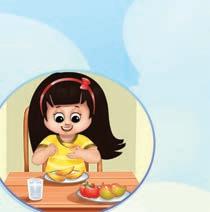

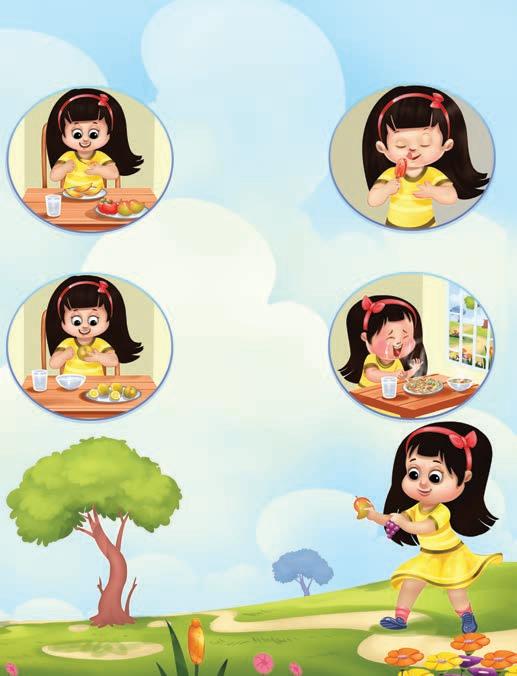


Little Miss Meena

Little Miss Meena
Loves things
sweet.
Mangoes and apples
Oh! What a treat!


Little Miss Meena
Also loves sour.
Lemons and grapes
Or orange bars!

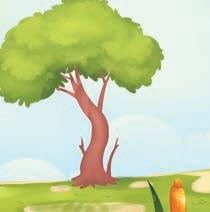
Little Miss Meena
Cannot have spice. She likes her meals, Hot and nice!


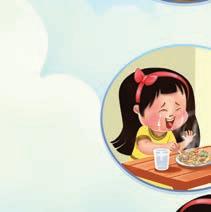
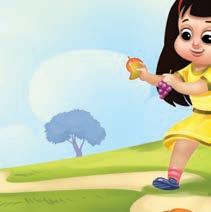







Say: .
Hello, children! In the last class, we heard a rhyme called Breakfast, Lunch, Dinner
It was about a boy who tells us when he eats breakfast, lunch and dinner. We also learnt the new words ‘breakfast’, ‘lunch’ and ‘dinner’.
You may include some exercises or actions, between the class, to keep the learners active and engaged.
Say:
Let us have some fun! I will do some actions and you will say what they are.
Instruct: Let us start.
Discuss


the keywords learnt in the previous class.







You may show flash cards of some food items and ask the learners at what time they eat these food items. They have to answer by saying ‘breakfast’, ‘lunch’ or ‘dinner’.
Say:
Wonderful! That was fun.
Instruct: Now, look at the pictures on page no. 45 carefully. Discuss some of these suggested questions while pointing at the pictures.
2.

What is the girl eating in the first picture?
(The girl is eating fruits / mangoes / apples.)
What is the girl eating in the second picture?
(The girl is eating an ice cream.)
3. Do you like to eat ice cream?
(Yes, I like to eat ice cream. / No, I do not like to eat ice cream.)
4. Do you cry when you eat spicy food? No,

(Yes, I cry when I eat spicy food. / No, I do not cry when I eat spicy food.)



Based on the learners’ responses, you may choose to ask a few follow-up questions on the illustrations.





Listen and Enjoy

Say: We will read a rhyme called You may choose to read play the Talking Book
Little Miss Meena. It is about a girl, Meena. We will read what Meena likes to eat and what she does not like to eat. Now let us begin reading. the rhyme aloud or . The first read is for the purpose of enjoyment and the second read is for the explanation of the rhyme.
You may first ask the learners whether they like to eat things that are sweet, sour, salty, hot or spicy. You can use learners’ home language to ask this question.



10 mins
Now, I will tell you what the rhyme means. Do not forget to point at the pictures while reading or explaining the rhyme. Pause at regular intervals / after each sentence and explain the meaning in the learners’ home the meaning of the keywords while reading the poem. Associate the words with
Say: language, if required. Explain the the suggested actions. no. Word Pronunciation

Sl. no.WordPronunciation

1 sweet sweet something that has lots of sugar in it sour sau.uh something that tastes like lemons bars baaz ice creams that have wooden spice spaais


something that has strong taste like chillies

act to lick your upper lip with your tongue act to close your eyes, squeeze your nose and bring your lips together creating loud noise sticks below them act to hold an imaginary ice cream bar and lick it act to produce the sound ‘ssssssss’ and move your hand like a fan near your face
You may pause at the annotations and ask these suggested questions.

What does Little Miss Meena love?
(Little Miss Meena loves sweet things.)
Can you name a sour thing that Miss Meena

(Miss Meena likes lemons / grapes / orange

Note: Refer to the previous page for annotations.
After
What does Little Miss Meena not like?
(Little Miss Meena does not like spice.)


How does Little Miss Meena like her meals? (Little Miss Meena likes her meals hot and


You may rephrase the learners’ responses into complete sentences and ask them to repeat those sentences after you. For example: Little Miss Meena loves sweet things.

In this rhyme, we read what Little Miss Meena likes to eat and what she does not like





Explain

Let’s Speak
the meanings of these keywords in the learners’ home language.
1. Instruct:
Say what I say. Do what I do.
sweet.
I eat sweet fruits.
Repeat 5–6 times.
2. Instruct:
eat
Say what I say. Do what I do. fruits.


13 mins
Do the action of licking your upper lip with your tongue.

I like to eat vegetables.
Repeat 5–6 times.
3. Instruct:
makes us strong.
Food is tasty.
Repeat 5–6 times.
Do the action of eating using your left hand as a plate.
Say what I say. Do what I do.
Do the action of creating an imaginary bowl using your left hand and trying to eat something with a spoon.




E & R Express
Ask
Say:
the learners, whom you may select randomly, to speak the sentences independently. Now, you will tell me the sentences with these keywords.
Instruct:
Tell me the sentence with the word ‘eat’. the process for all the keywords.
Repeat sentences.


If time permits, you may also invite the learners to speak the sentences with the words that were learnt in periods 1 and 2—‘hungry’, ‘cooks’, ‘vegetables’, ‘breakfast’, ‘lunch’ and ‘dinner’.

Say: Today, we learnt to speak words and sentences on food. We eat sweet, sour and spicy food. We learnt to speak the words ‘eat’, ‘food’ and ‘sweet’; and use them in
Homework
Say:
Today, you will tell your parents about the words and the sentences learnt in the class. You will show the actions for those words. You will tell them about the words ‘eat’,
‘food’ and ‘sweet’.

5 mins








































Let’s Speak

Discuss learnt
the keywords learnt in periods 1, 2 and 3.
Say what I say. Do what I do.
1. Instruct: hungry. of on
We all are hungry
Repeat 5–6 times.
Say what I say. Do what I do.
I eat dinner at night.


Do the action of putting your hand on your stomach and moving it in circles.

2. Instruct: your I eat dinner
Repeat 5–6 times.
3. Instruct: makes us strong.
Say what I say. Do what I do.
Food is tasty.
Repeat 5–6 times.
Repeat
Say:
Do the action of locking your arms and resting your head. with my family.
Do the action of creating an imaginary bowl using your left hand and trying to eat something with a spoon. the process for all the keywords.
E & R Express
Now, I will call you, one by one, so that you can speak the sentences for the words
related to food.
Invite
as many learners as possible to say the sentences.

Instruct: Tell me the sentence with the word ‘breakfast’. Repeat the process for all the keywords.

13 mins
E & R
You may use the actions or show flash cards while speaking the words so that the learners are able to associate and recall the sentences or phrases learnt for the words.

You may appreciate the learners if they share sentences other than those discussed in the class.


You may praise the learners for speaking confidently and correctly. You may say ‘Very good!’, ‘Keep it up!’ or ‘Brilliant!’. If learners hesitate, you may prompt them or guide them through actions or flash cards.









































Say:



Now, turn to page no. 48 of your book.
Explain:
There are some pictures given without the colours.
Instruct:
Look at the pictures and colour the things that you eat. For example: In the first row, you will colour the picture of the apple in red. You may ask these suggested questions.
Look at the first row. Can you tell the thing that you eat?
(I eat apples.)



2.
Do you like to eat mangoes?
(Yes, I like to eat mangoes. / No, I do not like to eat mangoes.)
3. (I eat a carrot.)
Can you name the thing that you eat given in the third row?
4.
Do you eat your food with a spoon?
(Yes, I eat my food with a spoon.)
Say:



In this chapter, we learnt to speak words, phrases and sentences related to food that we eat. We also talked about the time when we eat food.






As a part of the theme, learners will:
• learn about trees and plants.


• learn to say some keywords, phrases, and sentences related to trees and plants.






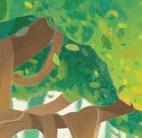






Plants and Trees


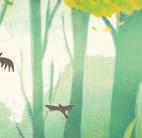
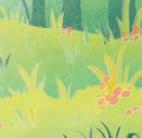
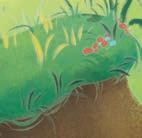


Say:



Good morning, children. Today, you will listen to the story—
Sam the Seed


Instruct: Look at the picture on page no. 49 carefully. Discuss some of these suggested questions while pointing to the pictures.

What do you see in the picture?
(I see trees, birds and some flowers.)
2.
How many birds are there?
(There are two birds.)
3. What is the colour of the tree?
3. (The colour of the tree is green / green and brown.)

4 Is there a tree near your house?

(The colour of the tree is green / green and brown.)
4. (Yes, there is a tree near my house. / No, there is no tree near my house.)



Based on the learners’ responses, you may choose to ask a few follow-up questions on the cover page.
You may rephrase the learners’ responses into complete sentences and ask them to repeat those sentences after you. For example: There are two birds.
Listen

Listen and Enjoy

Sam the Seed
Say: Wonderful! Now, we will read a story called . It is about a seed named Sam. He wants to grow up and see the world. The sun, the rain, the soil and his friend Eric the earthworm help him grow. Now, let us begin reading.
read the story aloud or the Talking Book is
You may choose to play . The first read is for the purpose of enjoyment and the second read is for the explanation of the story.
Say: Now, I will tell you what the story means.



10 mins
Do not forget to point at the pictures while reading or explaining the story. Pause at regular intervals and explain the meaning in the learners’ home language, if required.
You may modulate your voice and use expressions while reading the dialogues from the story to make it more interesting for your learners.


In advance, bring the seed of any seasonal fruit to the class to establish the contextual meaning of the word. Also, before the class begins, draw a beautiful and well-labelled picture of a plant on the board.





. He lives under the soil. He wants to
Soon, the magic begins to happen!


seed grow up and see kiss him.
In a few days, little

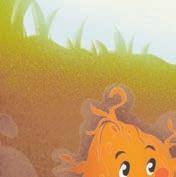


The warm light from the sun touches Sam. The little drops of rain roots pop out. The roots go deep into the soil and get food and water. “Yummy, Yummy,” says Sam, licking his Sam becomes friends with Eric, the earthworm. Eric tells Sam about the other plants in the garden.



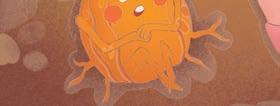









the meaning of the words while reading the story. Associate the words with the suggested actions and suggestions.

Sl. no.WordPronunciation


a small part of a plant from which a new plant grows
grow groh

to become bigger

roots roots

no. Word Pronunciation Meaning Action / Suggestion seed seed
show the seed to the class
put one palm over the other at the centre, move the hand on the top upwards

point at the roots in the labelled plants plaants
leaves leevz
flowers flau.uhz
the part of the plant which is under the ground diagram of the plant on the board a small living thing from which we get fruits, vegetables and flowers point at the plant drawn on the board
a part of the plant that is green and soft
point at the leaves in the labelled diagram of the plant on the board
a part of the plant which is colourful and soft act to join your hands and open it with your fingers spread and let the lower part of the palms touch each other

You may tell the learners that most of the fruits that we eat, like mango, apple, watermelon and orange, have seeds in them. These seeds, when planted in the soil, grow into plants.


What does Sam want to do?
You may pause at the annotations and ask these suggested questions.
(Sam wants to grow up and see the world.)
After
What do roots get?
(The roots get food and water.)
After
After


(Sam becomes a sunflower plant.)


Note: Refer to the next page for annotations 3 and 4.
Summarise



Say: In the story, we read about Sam, the seed. He gets food and water from the soil and grows into a sunflower plant.











In a few days, Sam is above the ground. Sam grows into a little
green plant. leaves flowers



“Wow! Look Eric, I am growing! I can see the world—the birds, bees and the butterflies!”. Sam says happily.
Soon, Sam becomes tall and strong. He has lots of bright green . He also has some pretty yellow ! Sam is a sunflower plant!
•



Every day, Eric tells him funny jokes. Bees and butterflies sit on the beautiful flowers. Sam is having the best time of his life!


Explain




Let’s Speak
the meanings of these keywords in the learners’ home language.
1. Instruct: Say what I say. seed
grows into a plant.
A seed is small.
Repeat 5–6 times.
2. Instruct: grow big.

Show the seed that you have brought to the class.
Say what I say. Do what I do.


13 mins
The plants grow into trees.
Repeat 5–6 times.
3. Instruct: Say what I say. plants plants
Repeat 5–6 times.
Do the action of putting one palm over the other at the centre, moving the hand on the top upwards.
Point at the plant drawn on the board.



E & R Express
E&R
Ask the learners, whom you may select randomly, to speak the sentences independently.
Say:
Instruct:
Repeat



Conclusion
Homework
Now, you will tell me the sentences with these keywords. Tell me the sentence with the word ‘seed’. the process for all the keywords. that E
Say: Today, you will tell your parents about the words and the sentences that you learnt in the class. You will tell them about the words ‘seed’, ‘grow’ and ‘plants’. You may show them a plant if you have any in your house. E&R
5 mins
Theme 7


Say: Today, we learnt to speak words and the sentences on seeds and plants. We talked about how a seed grows into a plant with the help of sun, food and water. We learnt to speak the words ‘seed’, ‘grow’ and ‘plants’; and use them in sentences.
2 mins




tree,
This is my song. Just sing along. roots




As they grow, They spread around.
My trunk grows up, With many leaves. It’s big and brown. Don’t cut me, please!


In my branches, Birds make nest, Monkeys jump,











Hello, children! In the last class, we heard a story called a seed called Sam. We heard how Sam the seed grows into a plant. We also learnt the
Say: Sam the Seed. It was about plant.
words ‘seed’, ‘grow’ and ‘plants’. have


Say: Let us have some fun! I will show some things or do some actions and you have to tell what they are.
Instruct:
Let us start.
Discuss the keywords learnt in the previous class.





Say:
Great! That was interesting.
Instruct: Now, look at the pictures on page no. 52 carefully.

What do you see in the picture?
2.

Discuss some of these suggested questions while pointing at the pictures.
(I see butterflies. / I see a tree. / I see a monkey. / I see a man and a girl.)
How many butterflies are there?
(There are three butterflies.)
What are the colours of the butterflies?
3. (The colours of the butterflies are yellow, pink and blue.)
4.
What is the monkey holding?
(The monkey is holding a banana.)

Where is the monkey?
(The monkey is on the tree.) •



You may compliment the learners on their efforts and rephrase their responses into complete sentences and ask them to repeat those sentences after you. For example: A seed grows into a plant. Theme


Based on the learners’ responses, you may choose to ask a few follow-up questions on the illustrations.






Listen and Enjoy
Say: We will read a rhyme called let
The Song of the Tree. In this rhyme, the tree tells us about its different parts. Now, let us begin reading.
You may choose to read play the Talking Book
the rhyme aloud or
. The first read is for the purpose of enjoyment and the second read is for the explanation of the rhyme.
Say: language, if required.
Now, I will tell you what the rhyme means.
Do not forget to point at the pictures while reading or explaining the rhyme. Pause at regular intervals / after each sentence and explain the meaning in the learners’ home


10 mins
Before reading the rhyme, draw a well-labelled picture of a tree on the board. You may add colours by using colourful chalks. Remember to point at the parts of the plant while reading about them.
Explain the meaning of the words while reading the rhyme. Associate the words with the suggestions.




Sl. no. Word Pronunciation Meaning
tree tree board
roots roots
trunk trungk

Sl. no.WordPronunciation Action / Suggestion
a tall plant that gives us shade, fruits, vegetables and nuts point at the tree drawn on the
a part of the plant which is under the ground point at the roots in the labelled diagram of the plant on the board
the brown part of a tree which is above the ground point at the trunk in the labelled diagram of the tree on the board
leaves leevz and soft

a part of the plant that is green point at the leaves in the labelled diagram of the tree on the board
branches braanch.uhz grow the board
nest nest
a thin part of a tree on which leaves, fruits and vegetables point at the branches in the labelled diagram of the plant on
houses that birds make on trees point at the nest in the labelled diagram of the plant on the board

During the day, if time permits, you may take the learners on a nature walk and show a big tree. You may point at the different parts of the tree.
You may pause at the annotations and ask these suggested questions.

Have you seen a big tree?

(Yes, I have seen a big tree.)
Where do the roots of the tree go?



(The trunk is big and brown.)

(The roots of the tree go deep in the ground.)
What does the trunk have?
(The trunk has many leaves.)
Refer to the previous page for annotations.
Summarise


Where do the birds make their nests? (The birds make their nests on the branches

In this rhyme, we read about the different parts of a tree.

Explain




Let’s Speak
the meanings of these keywords in the learners’ home language.
1. Instruct: Say what I say. of on the board.
Roots
grow in the ground. Point at the roots in the labelled diagram of the plant get food and water.
Repeat 5–6 times.
2. Instruct: Say what I say.



13 mins
The trunk is brown.
Repeat 5–6 times.
3. Instruct: Say what I say.
Birds make nest in
Repeat 5–6 times.
. plant on the board.
Ask
Say:
Instruct:

The trunk is tall. Point at the trunk in the labelled diagram of the tree on the board. branches Point at the branches in the labelled diagram of the branches the learners, whom you may select randomly, to speak the sentences independently. Now, you will tell me the sentences with these keywords. Tell me the sentence with the word ‘roots’. Repeat the process for all the keywords.

E & R
E & R Express 5 mins


Conclusion
Homework

Say: Today, we learnt to speak words and the sentences on trees. We talked about the different parts of a tree. We learnt to speak the words ‘roots’, ‘trunk’ and ‘branches’; and use them in sentences.
Say: Today, you will tell your parents about the words and the sentences learnt in the class. You can point at the picture given in the book and tell them what it is. You will tell them about the words ‘roots’, ‘trunk’ and ‘branches’.

If time permits, you may also invite the learners to speak the sentences with the words learnt in period 1—‘seed’, ‘grow’ and ‘plants’. Theme







My Dear Tree








, my dear tree,


Standing big and tall, You give us food And wood for the bed. A home for birds, A place to play, You look beautiful, I will care for you, In ways big or small. You are a gift to us









Good morning, children! In the last class, we heard a rhyme called The Song of the Tree It is about the different parts of a tree. We also learnt the new words ‘roots’, ‘trunk’ and
‘branches’.
Say: .
You may ask the learners where they see a tree. You will say the name of a place and the learners have to say ‘yes’ or ‘no’. For example: If you say ‘garden’, the learners will say ‘yes’.



Say: Let us have some fun! I will draw a picture of a tree on the board and point to a particular part. You have to say what it is.
Instruct: Let us start.
Discuss
the keywords learnt in the previous class.
What grows in the ground? (Roots grow in the ground.)
2. Is the trunk of a tree tall? (Yes, the trunk is tall.)
What has many branches? (The tree has many branches.)


Say:
3. Wonderful! That was fun.
Instruct: Now, look at the pictures on page no. 53 carefully.
Discuss some of these suggested questions while pointing at the pictures.
What do you see in the picture? (I see a tree / birds / eggs / squirrels.)
2. Is there a butterfly in the picture? (Yes, there is a butterfly.)
3. How many squirrels are there? (There are two squirrels.)

4. What is the colour of the big bird? (The colour of the big bird is blue.)


You may rephrase the learners’ responses into complete sentences and ask them to repeat those sentences after you. For example: Roots grow in the ground. Theme


Based on the learners’ responses, you may choose to ask a few follow-up questions on the illustrations.




Listen and Enjoy

Say: We will read a rhyme called
My Dear Tree. It is about the different ways in which the trees help us. Now let us begin reading.
You may choose to read play the Talking Book
the rhyme aloud or . The first read is for the purpose of enjoyment and the second read is for the explanation of the rhyme.
Say: language, if required. Explain suggested actions or suggestion.


Now, I will tell you what the rhyme means. Do not forget to point at the pictures while reading or explaining the rhyme. Pause at regular intervals / after each sentence and explain the meaning in the learners’ home the meaning of the words while reading the poem. Associate the words with the

10 mins


Sl. no. Word Pronunciation Meaning
tree tree a tall plant that gives us shade, fruits, vegetables and nuts
shade shayd an area that is cool and where there is no direct sunlight
food food
something that we eat
care kair to look after something



Sl. no.WordPronunciationMeaning Action / Suggestion
point at the tree drawn on the board
act join bring both your hands vertically to the front of your forehead and join them act to hold an imaginary bowl using your left hand and try to eat something with a spoon act to gently rub your shoulder or arms to suggest caring
You may pause at the annotations and ask these suggested questions.

How does the tree protect us from the sun?

What does tree give us for making beds?
(The tree gives us wood for making beds.)
Refer to the previous page for annotations.



After
How does the tree look on a rainy day? (The tree looks beautiful on a rainy day.)
What is a gift to us?
(Trees are a gift to us.)






In this rhyme, we read about the different ways in which trees help us.





Explain

Let’s Speak
the meanings of these keywords in the learners’ home language.
1. Instruct: Say what I say. tree is green. Point at the tree on the board.
The tree is tall.
Repeat 5–6 times.
2. Instruct: .
Say what I say. Do what I do.
I like yellow flowers
Flowers are beautiful.
Repeat 5–6 times.


Do the action of joining your hands and opening them with your fingers spread and letting the lower part of the palms touch each other.
3. Instruct: Say what I say. are green in colour.
Leaves grow on trees.
Repeat 5–6 times.
13 mins

Point at the leaves in the labelled diagram of the tree on the board.



E&R
E & R Express
Ask the learners, whom you may select randomly, to speak the sentences independently.
Say: Now, you will tell me the sentences with these keywords.
Instruct: Tell me the sentence with the word ‘leaves’.
Repeat

the process for all the keywords. E
If time permits, you may also invite the learners to speak the sentences with the words that were learnt in periods 1 and 2—‘seed’, ‘grow’, ‘plants’, ‘roots’, ‘trunk’ and ‘branches.
Conclusion

E&R
5 mins
2 mins
Homework
Theme 7

Say: Today, we learnt to speak words and sentences on trees. We learnt that trees give us shade, food to eat, wood for our bed and houses to birds and animals. We learnt to speak the words ‘leaves’, ‘flowers’ and ‘tree’; and use them in sentences.
Say: Today, you will tell your parents about the words and the sentences learnt in the class. You will tell them about the words ‘leaves’, ‘flowers’ and ‘tree’. You may also tell your parents how trees help us.



















Trees give us food.





• Plants and Trees




















 XPRE SS
XPRE SS



Let’s Speak

At the beginning of the class, draw a well-labelled diagram of a plant and a tree on the board.
Discuss learnt
the keywords learnt in periods 1, 2 and 3.
1. Instruct: Say what I say. plants
I water the plants
Repeat 5–6 times.


Point at the plant drawn on the board.
2. Instruct: Say what I say. trunk is tall. the board.

The trunk is brown.
Repeat 5–6 times.
3. Instruct: Say what I say.
Leaves grow on trees.
Repeat 5–6 times.
Repeat
the board.
Point at the trunk in the labelled diagram of the tree on are green in colour. Point at the leaves in the labelled diagram of the tree on the process for all the keywords.
E & R
E&R Express
Say:



Now, I will call you, one by one, so that you can speak the sentences for the words
related to plants and trees.
Invite
as many learners as possible to say the sentences.
Instruct:
Tell me the sentence with the word ‘trunk’. the process for all the keywords.
13 mins
Repeat E & R
You may ask the learners to point at the parts of the trees while speaking the words and sentences


















































Say:



Now, turn to page no. 56 of your book.
Explain:
Instruct:
An incomplete tree is given. You have to complete the tree and colour it. You have to trace the dotted lines to complete the tree. Then, colour it. You may ask these suggested questions.
What is the colour of the trunk?
(The colour of the trunk is brown.)



2. Is the trunk tall?
(Yes, the trunk is tall.)
3.
What is the colour of the leaves?
(The leaves are green in colour.)
4.
Do you see any bird in the tree?
(No, there is no bird in the tree.)
Say: We the



In this chapter, we learnt to speak words, phrases and sentences related to plants and trees. We learnt how a seed grows into a plant. We also learnt the different parts of a tree and the various things that trees give us.







As a part of the theme, learners will:
• learn the names of different animals and birds.


• learn to say some keywords, phrases and sentences related to animals and birds.





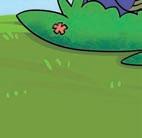

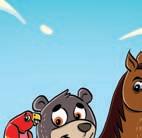





Birds and Animals










Say: Hello, little stars! Today, you will listen to the story—


Instruct: Look at the picture on page no. 57 carefully. Discuss some of these suggested questions while pointing to the pictures.

What do you see in the picture? (I see many animals.)
2. Do you see a cow in the picture? Point at the picture.
3.
(Yes, I see a cow.)

3. Have you ever seen a peacock dancing? (Yes, I have seen a peacock dancing. / No, I have not seen a peacock dancing.)

4 (The dog is black / brown.)

4. What is the colour of the dog in the picture?



Based on the learners’ responses, you may choose to ask a few follow-up questions on the cover page.
You may give a chance to as many learners as possible to respond to your questions. You may ask more questions on all the animals given in the picture.

You may rephrase the learners’ responses into complete sentences and ask them to repeat those sentences after you. For example: I see many animals.
Listen
Listen and Enjoy

Great! Now, we will read a story called . It is about a bear
Say: Bhola and His Friends named Bhola. Bhola was a naughty bear who made fun of other animals. So, the animals stopped talking to him. Now, let us begin reading. You may choose to Talking Book purpose of enjoyment and the second read is for the explanation of the story. Say:
read the story aloud or play the . The first read is for the Now, I will tell you what the story means.
Do not forget to point at the pictures while reading or explaining the story. Pause at regular intervals and explain the meaning in the learners’ home language, if required.


You may read the story with voice modulation, hand gestures and expressions to make it more interesting for the learners.
Theme 8


10 mins
 Bhola and His Friends
Bhola and His Friends





Bhola and His Friends
In the forest, there lives a bear named Bhola. He is a naughty bear. monkeys peacocks elephants
Bhola runs after the and the . He scares the and the snails. Bhola eats the ’ food.
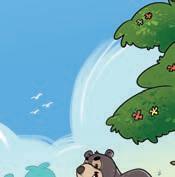




All the animals are angry with Bhola.










the meaning of the words while reading the story. Associate the words with the

Sl. no.WordPronunciation


bear beuh
monkeys muhng.keez
Meaning
a big animal that is brown or black with thick skin and
no. Word Pronunciation Action
claws
rabbits ra.buhts
peacocks pee.kawks
elephants eh.luh.fnts

1
Who does Bhola run after?
act to close your fists and pretend to beat them on your chest alternately animals that like to eat bananas and can hop, jump and climb trees act to fold your arms with your palms under your shoulders and act to scratch your body animals that are small, usually white, with long ears and can hop
act to bring both your hands near your chest, with fingers curved facing downwards and then hop
birds that have long and colourful wings act to raise your hands above your head with fingers spread, bring down your hands slowly sideways and shaking them

huge animals that are grey and have a very long nose act to put your right arm forward and touch the left hand to the right elbow, then move your right arm up and down in a wave
You may pause at the annotations and ask these suggested questions.
After 2
after does
(Bhola runs after the monkeys and the rabbits.)

How does Bhola feel when the animals stop talking to him?
(Bhola feels sad when the animals stop talking to him.)
After 3
What does Bhola get for his friends?
(Bhola gets fruits and juice for his friends.)
After 4


What does Bhola promise not to do? (Bhola promises not to tease his friends.)


Note: Refer to the next page for annotations 3 and 4.
Summarise



Say: In this story, we read about Bhola, the bear. He would tease his friends the monkeys, the rabbits, the peacocks, the snails and the elephants. When they stop talking to him, he promises not to tease them again.
Theme 8






One day, he has an idea.
“I can call my friends for a picnic!” he said.
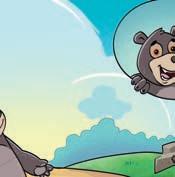

Bhola quickly gets fruits and juice for his friends. He asks them to join the picnic.
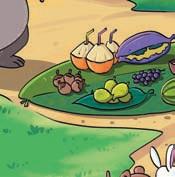

All of them ask, “Bhola, did you get
these for us?”

please?” elephants.
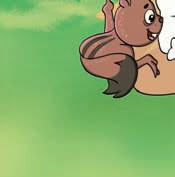




“Yes”, he says. “I promise to not tease you. Can we be friends again, “YES”, say the monkeys, the rabbits, the peacocks, the snails and the Bhola and all the other animals are friends again.








Explain
Let’s Speak

1. Instruct: monkey jumps.
the meanings of these keywords in the learners’ home language. Say what I say. Do what I do.
The monkey
Repeat 5–6 times.
2. Instruct: peacock dances.
Do the action of folding your arms with your palms under your shoulders and scratching your body. is in the tree.
Say what I say. Do what I do.
A peacock is a bird.
Repeat 5–6 times.



Do the action of raising your hands above your head with fingers spread and bringing down your hands slowly sideways and shaking them.
3. Instruct: Say what I say. Do what I do. elephant is so big.

The elephant has big ears.
Repeat 5–6 times.
Do the action of putting your right arm forward and touching the left hand to the right elbow, then moving your right arm up and down in a wave.
13 mins

You may help the learners to frame sentences on the colour and physical features of the animals. For example, ‘A monkey is brown.’, ‘An elephant has big ears.’, ‘A peacock is blue and green.’
E&R
E & R Express
Ask the learners, whom you may select randomly, to speak the sentences independently.
Say:
Instruct:
Repeat


E&R
5 mins

Conclusion
Homework
Now, you will tell me the sentences with these keywords. Tell me the sentence with the word ‘monkey’. the process for all the keywords. that
Theme 8

Say: Today, we learnt to speak words and the sentences on animals and birds. We talked about animals like a bear, monkey, rabbit, peacock and elephant. We learnt to speak the words ‘monkey’, ‘peacock’ and ‘elephant’; and use them in sentences.
Say: Today, you will tell your parents about the words and the sentences that you learnt in the class. You will show the actions for those words. You will tell them about the words ‘monkey’, ‘peacock’ and ‘elephant’.

2 mins






Up in the sky!


Beautiful Birds









Crows
Pigeons
are black, grey and blue,


I love them all, You should too!








Sparrow chirps, Cuckoo sings. Look at the parrot!

With colourful wings!
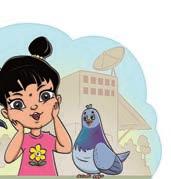







Say: morning, Bhola and His Friends
Good morning, children! In the last class, we heard a story called It was about a bear Bhola who used to make fun of other animals. When the animals stopped talking to him, he promised not to make fun of them again. We also learnt the
words ‘monkey’, ‘peacock’ and ‘elephant’.


Say: Let us have some fun! I will do some actions and you will say who they are.
Instruct:
Let us start.
Discuss the keywords learnt in the previous class.





You may rephrase the learners’ responses into complete sentences and ask them to repeat those sentences after you. For example: The monkey jumps.
Say:
Wonderful! That was fun.

What do you see in the picture?
(I see many birds. / I see a girl.)
Instruct: Now, look at the pictures on page no. 60 carefully. Discuss some of these suggested questions while pointing at the pictures.
(There are twelve birds.)
2. Let us do some counting. How many birds are there in the first picture?
3.
Have you seen a bird flying?
(Yes, I have seen a bird flying.)
4.

Have you seen a black coloured bird?
(Yes, I have seen a black coloured bird. / No, I have not seen a black coloured bird.)

(Yes, •

If time permits, you may take the learners out in the school playground and spot the birds flying or sitting. Then, you may tell them the birds’ colours or names.
Based on the learners’ responses, you may choose to ask a few follow-up questions on the illustrations.





Listen and Enjoy

Say: We will read a rhyme called You may choose to read play the Talking Book
Beautiful Birds. It is about different birds and what they do or look like. Now, let us begin reading.
the rhyme aloud or . The first read is for the purpose of enjoyment and the second read is for the explanation of the rhyme.
Say: language, if required.
Now, I will tell you what the rhyme means.
Do not forget to point at the pictures while reading or explaining the rhyme. Pause at regular intervals / after each sentence and explain the meaning in the learners’ home



You may read the rhyme with voice modulation, hand gestures and in tune to make it interesting for the
Explain
the meaning of the words while reading the rhyme. Associate the words with the suggested actions and suggestion.



10 mins
Sl. no. Word Pronunciation Meaning Action / Suggestion birds buhdz living things that have feathers and wings, usually can fly parrot pa.ruht a bird that can repeat what we say, usually is green in colour with a red beak

act to extend your arms sideways, and flap them like wings
show flash cards of parrots that are green in colour with red beaks birds that are black in colour produce the sound of ‘caw-caw’ birds that are grey and blueproduce the sound of ‘coo-coo’ You may pause at the annotations and ask these suggested questions.

crows kroze birds that are black in colour pigeons pi.jnz blue produce




Refer to the previous page for annotations.


What is the colour of a crow?
Which birds are grey and blue? (Pigeons are grey and blue.)






In this rhyme, we read about different birds like parrots, sparrows, cuckoos, crows and


Explain




Let’s Speak
the meanings of these keywords in the learners’ home language.
1. Instruct: Say what I say. parrot can talk. red beaks.
Show flash cards of parrots that are green in colour with
The parrot is green.
Repeat 5–6 times.
Say what I say. Do what I do.
2. Instruct: crow of



13 mins
The is black. Do the action of producing the sound of ‘caw-caw’.
The crow can fly.
Repeat 5–6 times.
3. Instruct:
Say what I say. Do what I do.
pigeon can fly.


The pigeon
Do the action of producing the sound of ‘coo-coo’. is grey and blue.
Repeat 5–6 times.
You may show flash cards of birds that are not given in the poem, like duck, owl, hen, etc.
E & R Express
Ask
Say:

Instruct:
Repeat
the learners, whom you may select randomly, to speak the sentences independently. Now, you will tell me the sentences with these keywords.
Tell me the sentence with the word ‘parrot’. the process for all the keywords.


E & R
5 mins

You may praise the learners for speaking confidently and correctly. You may say ‘Very good!’, ‘Well done!’ or ‘Fantastic!’. If the learners hesitate, you may prompt them or guide them through actions or flash cards.
If time permits, you may also invite the learners to speak the sentences with the words learnt in period 1—‘monkey’, ‘peacock’ and ‘elephant’.
Conclusion
Homework
Theme 8

Say: Today, we learnt to speak words and the sentences on birds. We talked about birds like sparrow, cuckoo, parrot, crow and pigeon. We learnt to speak the words ‘parrot’, ‘crow’ and ‘pigeon’; and use them in sentences.
Say: Today, you will tell your parents about the words and the sentences learnt in the class. You will tell them about the words ‘parrot’, ‘crow’ and ‘pigeon’.








The animals play,




The Animal Village



The hens and the goats Have fun all day.


Is white and strong,


The horse named Piku

The cow called Leela Sings all day long!
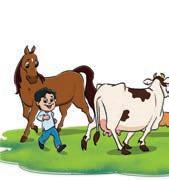







The cat says “meow”, The dog


barks “boww”,


They fight all day I don’t know how!
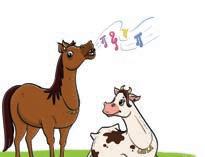
I play with them



All day and night. We live together, And sleep tight!








Say: Beautiful Birds. It was about
Hello, children! In the last class, we heard a rhyme called different birds. We also learnt the new words ‘parrot’, ‘crow’ and ‘pigeon’.



Say: Let us have some fun! I will make some sound or show flash cards and you will say who they are.
Instruct:
Let us start.
Discuss the keywords learnt in the previous class.





Say:
Great! That was interesting.
You may rephrase the learners’ responses into complete sentences and ask them to repeat those sentences after you. For example: The parrot can talk.

Instruct: Now, look at the pictures on page no. 61 carefully.
Discuss some of these suggested questions while pointing at the pictures.
Which animals do you see in the first picture?
(I can see a cow / a horse / a goat / a hen.)
2.
Have you ever sat on a horse?

(Yes, I have sat on a horse. / No, I have not sat on a horse.)
3. Which animals can you see in the second picture?
(I can see a dog and a cat.)




4. (Yes, I think dogs and cats fight. / No, I do not think cats and dogs fight.)
Have you seen a cow near your house?

Do you think dogs and cats fight? cats
(Yes, I have seen a cow near my house. / No, I have not seen a cow near my house.)


Based on the learners’ responses, you may choose to ask a few follow-up questions on the illustrations.






Listen and Enjoy
Say: We will read a rhyme called
The Animal Village. It is about a village where different animals play together. Now let us begin reading.
You may choose to read play the Talking Book
the rhyme aloud or
. The first read is for the purpose of enjoyment and the second read is for the explanation of the rhyme.
You may read the rhyme with voice modulation, hand gestures and in rhythm to make it interesting for the learners. You may also produce the sound of the animals while reading the words like ‘meow’ and ‘boww’.
Say:


Now, I will tell you what the rhyme means.
language, if required.
10 mins

Do not forget to point at the pictures while reading or explaining the rhyme. Pause at regular intervals / after each sentence and explain the meaning in the learners’ home the meaning of the words while reading the poem. Associate the words with the
Explain suggested actions.

Sl. no.WordPronunciation

no. Word Pronunciation Meaning Action
1 goat gote black and white
cat cat white, usually runs after mice
dog dawg can be brown, black or white
cow kau



produce the sound of ‘baa-baa’
produce the sound ‘meow-meow’
produce the sound ‘boww-woww’
gives us milk ‘moo-moo’
a small animal that has horns and is a small animal that is black, brown or an animal that is usually kept as a pet, an animal that is white and black and produce the sound an animal that is brown or black, we
horse haws can sit on it and go places
You may pause at the annotations and ask these suggested questions.

Which animals have fun all day?
(Hens and goats have fun all day.)
After



(The cow is white and strong.)
Refer to the previous page for annotations.
produce the sound ‘neigh-neigh’
After
What does the horse, Piku, do? (The horse, Piku, sings all day.)
Do you like to play with animals or pets?


(Yes, I like to play with animals. / No, I do not like to play with animals.)


You may rephrase the learners’ responses into complete sentences and ask them to repeat those The cow is white and strong.
In this rhyme, we read about different animals like horse, cow, goat, hen, dog and cat.





Explain

Let’s Speak
the meanings of these keywords in the learners’ home language.
1. Instruct:
Say what I say. Do what I do.
cat says meow.
The cat drinks milk.
Repeat 5–6 times.
2. Instruct:
Say what I say. Do what I do.

Do the action of producing the sound ‘meow-meow’.

13 mins
The dog barks.

The dog eats a bone.
Repeat 5–6 times.
3. Instruct:
Ask
Say:
Do the action of producing the sound ‘boww-woww’.
Say what I say. Do what I do.
horse is brown.
The horse runs fast.
Repeat 5–6 times.
E & R Express
Do the action of producing the sound ‘neigh-neigh’.
the learners, whom you may select randomly, to speak the sentences independently. Now, you will tell me the sentences with these keywords.
Instruct:
Repeat
Tell me the sentence with the word ‘cat’. the process for all the keywords.



E & R
5 mins
If time permits, you may also invite the learners to speak the sentences with the words that were learnt in periods 1 and 2—‘monkey’, ‘peacock’, ‘elephant’, ‘parrot’, ‘crow’ and ‘pigeon’.
Say:
Today, we learnt to speak words and sentences on animals. We learnt how some animals look and what they say. We learnt to speak the words ‘cat’, ‘dog’ and ‘horse’; and
use them in sentences.
Homework
Say: possible.


Today, you will tell your parents about the words and the sentences learnt in the class. You will make the sound produced by these animals. You will tell them about the words ‘cat’, ‘dog’ and ‘horse’. You may also ask your parents to show these animals, if



















• Birds and Animals














 XPRE SS
XPRE SS



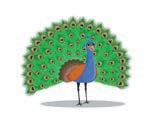











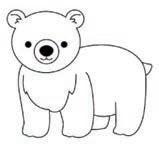







Say:



Now, turn to page no. 64 of your book.
Explain:
There are some coloured pictures of birds and animals given. There are also pictures of the birds and animals without the colour.
Instruct:
You have to match the animals and then colour them. Look at the example. You may ask these suggested questions.
Which bird can dance?
(Peacocks can dance.)



2.
Which animal has a long nose?
(An elephant has a long nose.)
3. Is an elephant a bird?
(No, an elephant is not a bird.)
4.
What is the colour of the bear?
(The bear is brown in colour.)
Say: produce.



In this chapter, we learnt to speak words, phrases and sentences related to different birds and animals. We also learnt how some birds and animals look and the sounds they






As a part of the theme, learners will:


• learn about their neighbourhood and the common places around them.
• learn to say some keywords, phrases and sentences related to neighbourhood.



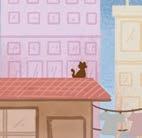
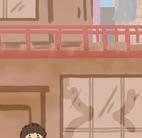
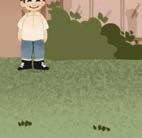







My Neighbourhood










Say: Beautiful Sundays
Good morning, children. Today, you will listen to the story—



What do you see in the picture?
Instruct: Look at the picture on page no. 65 carefully. Discuss some of these suggested questions while pointing at the pictures.
(I see a boy. / I see a dog. / I see houses. / I see a shop.)
2. Can you see a cow in the picture? Point and show.
(Yes, I can see a cow.)
3. Is there a shop near your house?
3. (Yes, there is a shop near my house. / No, there is no shop near my house.)

4 What is near your house?
4. (There is a garden / park / hotel near my house.)




Based on the learners’ responses, you may choose to ask a few follow-up questions on the cover page.
You may rephrase the learners’ responses into complete sentences and ask them to repeat those sentences after you. For example: Yes, I can see a cow.
Listen

Listen and Enjoy

Wonderful! Now, we will read a story called . It is about a boy
Say: Beautiful Sundays named Rohan. He tells us what he does and where he goes on Sundays. Now, let us begin reading.
You may choose to
Talking Book purpose of enjoyment and the second read is for the explanation of the story. Say:
read the story aloud or play the . The first read is for the Now, I will tell you what the story means.
Do not forget to point at the pictures while reading or explaining the story. Pause at regular intervals and explain the meaning in the learners’ home language, if required.


You may read the story with voice modulation, hand gestures and expressions to make it more interesting for the learners.



10 mins




Beautiful Sundays

Good morning! My name is Rohan. I love Sundays!
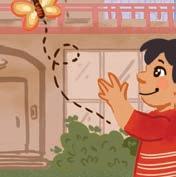









with my grandmother and grandfather. It is full of pretty flowers. There are colourful butterflies too! I run after them. I also love the mango tree
in my garden.









the meaning of the words while reading the story.

Sl. no. Word Pronunciation

garden gaa.dn
Meaning
market maa.kit
shops shawps
park paak

a small place joining a house where grass, plants and flowers grow
a place where we go to buy things
places from where we buy things, usually rooms where things are kept
a place where many people go to walk, play or run and also, plants and trees grow there


For all the words, you may either point at the illustrations or show flash cards to the learners. This will help them understand the meaning in context.
You may pause at the annotations and ask these suggested questions.

1
Where does Rohan walk with his grandmother and grandfather? (Rohan walks in the garden with his grandmother and grandfather.)
After 2
Where does Rohan go with his parents? (Rohan goes to the market with his parents.)
After 3
What does Rohan buy from the shops? (Rohan buys milk, vegetables and fruits.)
After 4

Where does Rohan go with his friends? (Rohan goes to the park with his friends.)



Note: Refer to the next page for annotations 2, 3 and 4.
Summarise


Say: In the story, we read about Rohan and the places that he goes to on Sundays.

At the end of the story, you may ask the learners questions based on their experiences. For example: ‘Who do you go to the park with?’ or ‘Have you gone to buy something from a shop?’


 Theme
Theme



market with my parents.
We buy many things from the there—milk, vegetables, and fruits. I also help them carry
the things we buy.
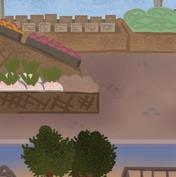



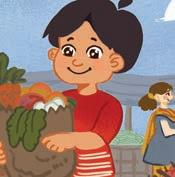


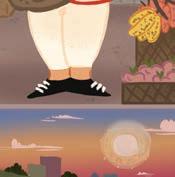


In the evenings, I go to the them for hours. We also run around on the soft grass.
park with my friends. It has so many swings and slides. We play on I love Sundays. What about you?







Explain

Let’s Speak
the meanings of these keywords in the learners’ home language.
1. Instruct: Say what I say. garden.
I see flowers in the .
Repeat 5–6 times.
garden
2. Instruct: Say what I say. market.

I see many things in the market.
Repeat 5–6 times.
3. Instruct: Say what I say. park.
I run in the park.




13 mins




Repeat 5–6 times. E &
E&R
Ask the learners, whom you may select randomly, to speak the sentences independently.
Say:
Instruct:
Repeat



Conclusion
Homework
Now, you will tell me the sentences with these keywords. Tell me the sentence with the word ‘garden’. the process for all the keywords. that
5 mins
Say: Today, we learnt to speak the words and the sentences on the places in our neighbourhood. We talked about the places that Rohan goes to on Sundays. We learnt to speak the words ‘garden’, ‘market’ and ‘park’; and use them in sentences.
Theme 9
• My Neighbourhood


Say: Today, you will tell your parents about the words and the sentences that you learnt in the class. You will tell them about the words ‘garden’, ‘market’ and ‘park’. You may point at the pictures in the book. Also, ask them to take you for a walk and show you the different places around your house.






Things in My Neighbourhood

shops
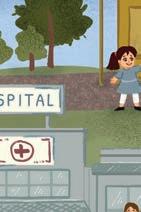






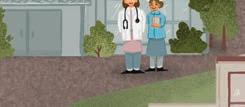

Hospitals too, Here and there.


In the Police station, Day and night.
The police officers

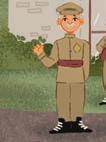








Hello, children! In the last class, we heard a story called about a boy called Rohan. We heard the places that Rohan goes to on Sundays. We also learnt the words ‘garden’, ‘market’ and ‘park’.


Instruct:
Say: Beautiful Sundays. It was have Let us start.
Discuss the keywords learnt in the previous class.
What do you do in the garden?
(I walk in the garden.)
2.
Do you go to the market?
(Yes, I go to the market.)
3.
Where do you play?

Say: Let us have some fun! I will show some flash cards and you will say what they are.

(I play in the park.)
You may rephrase the learners’ responses into complete sentences and ask them to repeat those sentences after you. For example: I walk in the garden.
Say:
Wonderful! That was fun.

Instruct: Now, look at the pictures on page no. 68 carefully. Discuss some of these suggested questions while pointing at the pictures.

2.
(Yes, I see a hospital.)
Is there a hospital near your house?

Do you see a hospital in the picture? Point and show it to me.

(Yes, there is a hospital near my house. / No, there is no hospital near my house.)
3. Is there a vegetable-seller in the picture? Point and show her to me. (Yes, there is a vegetable-seller in the picture.)

(Yes, is (Yes, is (Yes,

4. Have you seen a policeman? Where have you seen him? (Yes, I have seen a policeman. I have seen him on the road / outside school / in a film. / No, I have not seen a policeman.)



Based on the learners’ responses, you may choose to ask a few follow-up questions on the illustrations.




Listen and Enjoy

Say: We will read a rhyme called house. Now, let us begin reading. You may choose to read play the Talking Book
Things in My Neighbourhood. It is about the things that we may see in our neighbourhood. Our neighbourhood is places that are around our the rhyme aloud or
. The first read is for the purpose of enjoyment and the second read is for the explanation of the rhyme.
Say:


Now, I will tell you what the rhyme means. Do not forget to point at the pictures while reading or explaining the rhyme. Pause at regular intervals / after each sentence and explain the meaning in the learners’ home language, if required.
You may read the rhyme with voice modulation, hand gestures and in rhythm to make it interesting for the learners.
Explain suggested actions and suggestions.
10 mins

the meaning of the words while reading the rhyme. Associate the words with the

Sl. no. Word Pronunciation Meaning


Sl. no.WordPronunciation Action / Suggestion show flash cards of a house surrounded by different places show flash cards of shops with clothes or stationery act to show a plus sign using your
1 neighbourhood nay.buh.huud places that are near our house shops shawps places from where we buy things, usually rooms where things are kept hospitals haw.spuh.tlz places where sick people are treated hands police station pu.lees stay a place where police officers work and people who do wrong to others are kept

.shn act to salute by bringing your right hand close to your forehead


You may pause at the annotations and ask these suggested questions. (Nurses and doctors treat us with care.)
Refer to the previous page for annotations.

What do the police officers do? (Police officers make things right.)




In this rhyme, we read about the things that are there in the little girl’s neighbourhood. There are shops, hospitals, and a police station in the neighbourhood.

Explain



Let’s Speak

the meanings of these keywords in the learners’ home language.
1. Instruct: Say what I say. shop
I go to a shop.
Repeat 5–6 times.
2. Instruct:
Say what I say. Do what I do.


Show the flash card or illustration of a shop.

13 mins
hospital hospital
. Do the action of showing a plus sign using your hands. Nurses work in a
Repeat 5–6 times.
Say what I say. Do what I do.
police station
3. Instruct: . close to your forehead. I see a police station.
Repeat 5–6 times.
Ask
Say:
E & R Express



Do the action of saluting by bringing your right hand
Instruct: Tell me the sentence with the word ‘shop’. Repeat the process for all the keywords.



5 mins the learners, whom you may select randomly, to speak the sentences independently. Now, you will tell me the sentences with these keywords.
Conclusion
Homework

E&R
E & R
If time permits, you may also invite the learners to speak the sentences with the words learnt in period 1—‘garden’, ‘market’ and ‘park’.
Say: Today, we learnt to speak words and the sentences on neighbourhood. We talked about places that we might see in our neighbourhood. We learnt to speak the words, ‘shop’, ‘hospital’ and ‘police station’; and use them in sentences.


2 mins
Say: Today, you will tell your parents about the words and the sentences learnt in the class. You will tell them about the words ‘shop’, ‘hospital’ and ‘police station’.





Best of All







Houses are clean, colours so bright, Neighbours to help, day and night.
Roads to drive, footpaths to walk, A swimming pool, after the block.








Library for books, restaurant to eat, Wherever I go, I have friends to meet.


 Theme
Theme



Hello, children! In the last class, we heard a rhyme called Things in My Neighbourhood It was about the places that we can see in our neighbourhood like shops, hospitals and police station. We also learnt the new words ‘shop’, ‘hospital’ and ‘police station’.
Say:
what they are.
Instruct: Let us start.
Discuss


Say: .

Let us have some fun! I will do some actions or show flash cards and you will say the keywords learnt in the previous class.



Say:

I buy things from the shop.
Wonderful! That was fun.
Instruct: Now, look at the pictures on page no. 69 carefully.
Discuss some of these suggested questions while pointing at the pictures.
What do you see in the picture?
(I see children. / I see cars. / I see a swimming pool.)
2.
Do you play with your friends in the park?

You may include some stretching exercises or actions, between the class, to keep the learners active Theme
(Yes, I play with my friends in the park. / No, I do not play with my friends in the park.)
3. Do you like to go in the swimming pool?
4. Is there a park near your house?

(Yes, I like to go in the swimming pool. / No, I do not like to go in the swimming pool.)
(Yes, there is a park near my house. / No, there is no park near my house.)



Based on the learners’ responses, you may choose to ask a few follow-up questions on the illustrations.




Listen and Enjoy

Say: We will read a rhyme called
Best of All. It is about the places that are in the neighbourhood. Now let us begin reading.
the rhyme aloud or
You may choose to read play the Talking Book
. The first read is for the purpose of enjoyment and the second read is for the explanation of the rhyme.
Say: Explain suggested actions.
Now, I will tell you what the rhyme means.

Do not forget to point at the pictures while reading or explaining the rhyme. Pause at regular intervals / after each sentence and explain the meaning in the learners’ home language, if required.

10 mins

the meaning of the words while reading the poem. Associate the words with the

Sl. no.WordPronunciation

Sl. no. Word Pronunciation Meaning
roads rodez
a place on which cars, scooters, bicycles, auto-rickshaws and buses run
swimming pool svi.ming a place which has water in it and you can swim in it

library lai.bruh.ree


act to keep your palms parallel facing each other and move them together in a zigzag way pool act to join your palms horizontally and then open them outwards in a semicircle as if swimming
take a book from there act to hold an open book in one hand and bring your index finger of the other hand close to your mouth vertically
a place where many books are kept; you can read a book or restaurant reh.strawnt a After

.strawnta place where we go to eat food act to sit on a chair and hold imaginary spoon and chew food
You may pause at the annotations and ask these suggested questions.
Does your neighbourhood have a place where
(Yes, there has a place where my family can party. / No, my neighbourhood does not have

Do neighbours help us when we need them? (Yes, neighbours help us when we need them.)



What are roads for? (Roads are for driving.)
What are restaurants for? (Restaurants are to eat food in.)



Refer to the previous page for annotations.
You may ask the learners to name the places that they commonly see in their neighbourhood.
In this rhyme, we read about the places that are there in the neighbourhood like gym, party hall, restaurant, swimming pool, etc. We learnt what these places are for.



Explain

Let’s Speak



the meanings of these keywords in the learners’ home language.
Say what I say. Do what I do.
roads
1. Instruct: . your
We ride bicycles on
Repeat 5–6 times.
2. Instruct:
Say what I say. Do what I do.

13 mins
Do the action of keeping your palms parallel facing each other and moving them together in a zigzag way. roads
I swim in the swimming pool
I swim in the swimming pool
Repeat 5–6 times.

on Sunday.

Do the action of joining your palms
horizontally and then opening them outwards in a semicircle as if swimming.
3. Instruct: Say what I say. Do what I do. library. in library
Do the action of holding an open book in one hand and bringing your index finger of the other hand close to your mouth vertically.
Repeat 5–6 times.



E & R Express
E&R
Ask the learners, whom you may select randomly, to speak the sentences independently.
Say:
Instruct:
Repeat

Now, you will tell me the sentences with these keywords. Tell me the sentence with the word ‘roads’. the process for all the keywords. E

If time permits, you may also invite the learners to speak the sentences with the words that were learnt in periods 1 and 2—‘garden’, ‘market’, ‘park’, ‘shop’, ‘hospital’ and ‘police station’.
Conclusion
E&R
5 mins
Theme 9
• My Neighbourhood

Say: Today, we learnt to speak words and sentences on our neighbourhood. We read about the places that are in our neighbourhood. We learnt to speak the words and sentences on ‘roads’, ‘swimming pool’ and ‘library’; and use them in sentences. Homework
Say: Today, you will tell your parents about the words and the sentences learnt in the class. You will tell them about the words ‘roads’, ‘library’ and ‘swimming pool’. You may ask your parents whether these places are in your neighbourhood or not.

2 mins





































 XPRE SS
XPRE SS
Let’s Speak

Discuss learnt



the keywords learnt in periods 1, 2 and 3.
1. Instruct: Say what I say. market. card the class.
I go to the market
Repeat 5–6 times.
Show a flash card or an illustration of a market to with my mother.
2. Instruct: .
Say what I say. Do what I do.
Doctors work in hospital
Nurses work in a Repeat 5–6 times.
3. Instruct:


Repeat
Say:

Do the action of showing a plus sign using your hands. hospital
Say what I say. Do what I do.
roads
We ride bicycles on .
Repeat 5–6 times.
the process for all the keywords.
E & R Express
related to neigbourhood.
Invite
Do the action of keeping your palms parallel facing each other and moving them together in a zig-zag way. roads
Now, I will call you, one by one, so that you can speak the sentences for the words
as many learners as possible to say the sentences.

Instruct: Tell me the sentence with the word ‘hospital’.
Repeat the process for all the keywords.

13 mins
E & R
You may use the actions or show flash cards while speaking the words so that the learners are able to associate and recall the sentences or phrases learnt for the words.



You may appreciate the learners if they share sentences other than those discussed in the class. Theme






Say:
Now, turn to page no. 72 of your book.
Explain: the park.
There is a fun game. Rohan has to reach the park. You have to help Rohan reach
Instruct: park.
Draw line to show how Rohan will reach the park. You may ask these suggested questions.
Is there a shop on Rohan’s way?
(Yes, there is a shop.)



2.
Will Rohan find a hospital on his way to the park?
(Yes, Rohan will find a hospital on his way to the park.)
Is there a hospital near your house?
3. 4.
Say:
(Yes, there is a hospital near my house. / No, there is no hospital near my house.)
Is the park near or far from your house?
(The park is near / far from my house.)

In this chapter, we learnt to speak words, phrases and sentences related to places that we may see in our neighbourhood, around our house, like gym, library, restaurant, hospital, police station, garden, park etc.







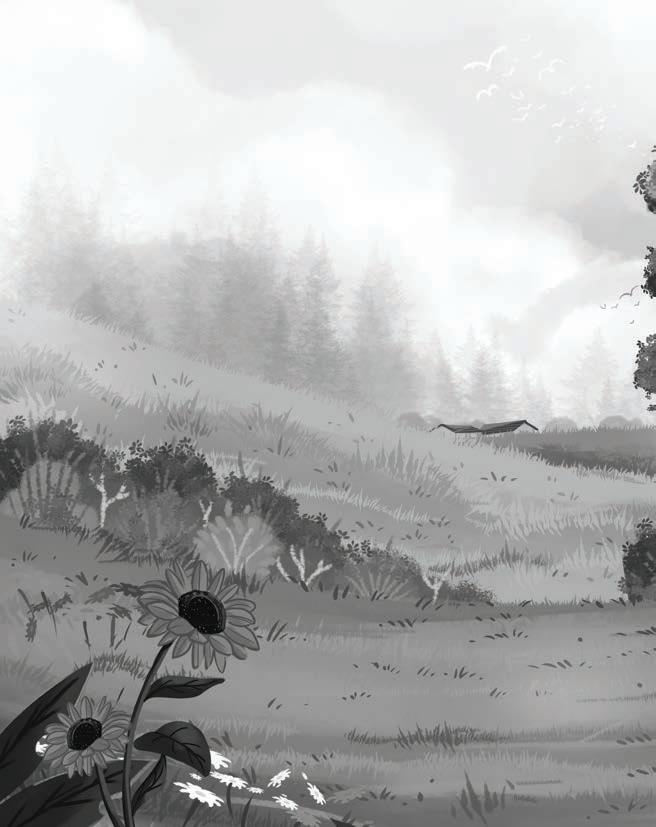

About This Book
The Conversations book is a vibrant educational resource tailored for young learners whose native language is not English. Comprising engaging stories and charming poems, this book offers a joyful way to build age-appropriate English listening skills, common vocabulary, and everyday expressions in the language. The activities are teacher-led and are based on the acclaimed ‘Total Physical Response’ (TPR) approach, enabling young learners to practise English speaking and listening skills in a manner that is fun and interactive.


Special Features
• Activity-based Learning: The book offers joyful and experiential activities that build English communication competencies.
• Texts as per NEP 2020 Themes: The book has exciting and stimulating texts that pave the way for English communication activities.
• Teachers’ Manual: The book is complemented by the Teachers’ Manual that enables teachers to conduct each session effectively.
About Uolo


Uolo partners with K-12 schools to provide technology-based learning programs. We believe pedagogy and technology must come together to deliver scalable learning experiences that generate measurable outcomes. Uolo is trusted by over 10,000 schools across India, South East Asia and the Middle East.



